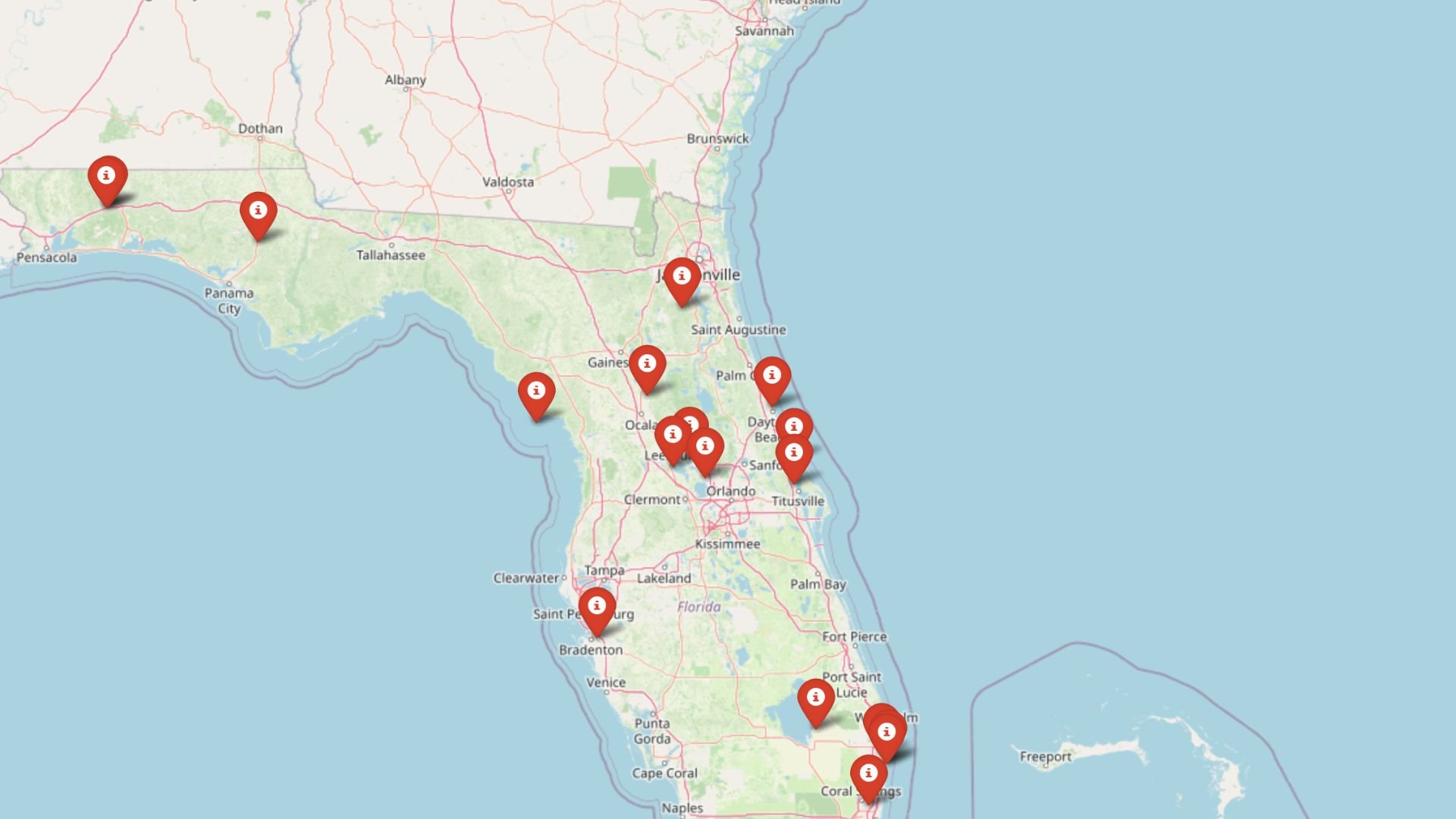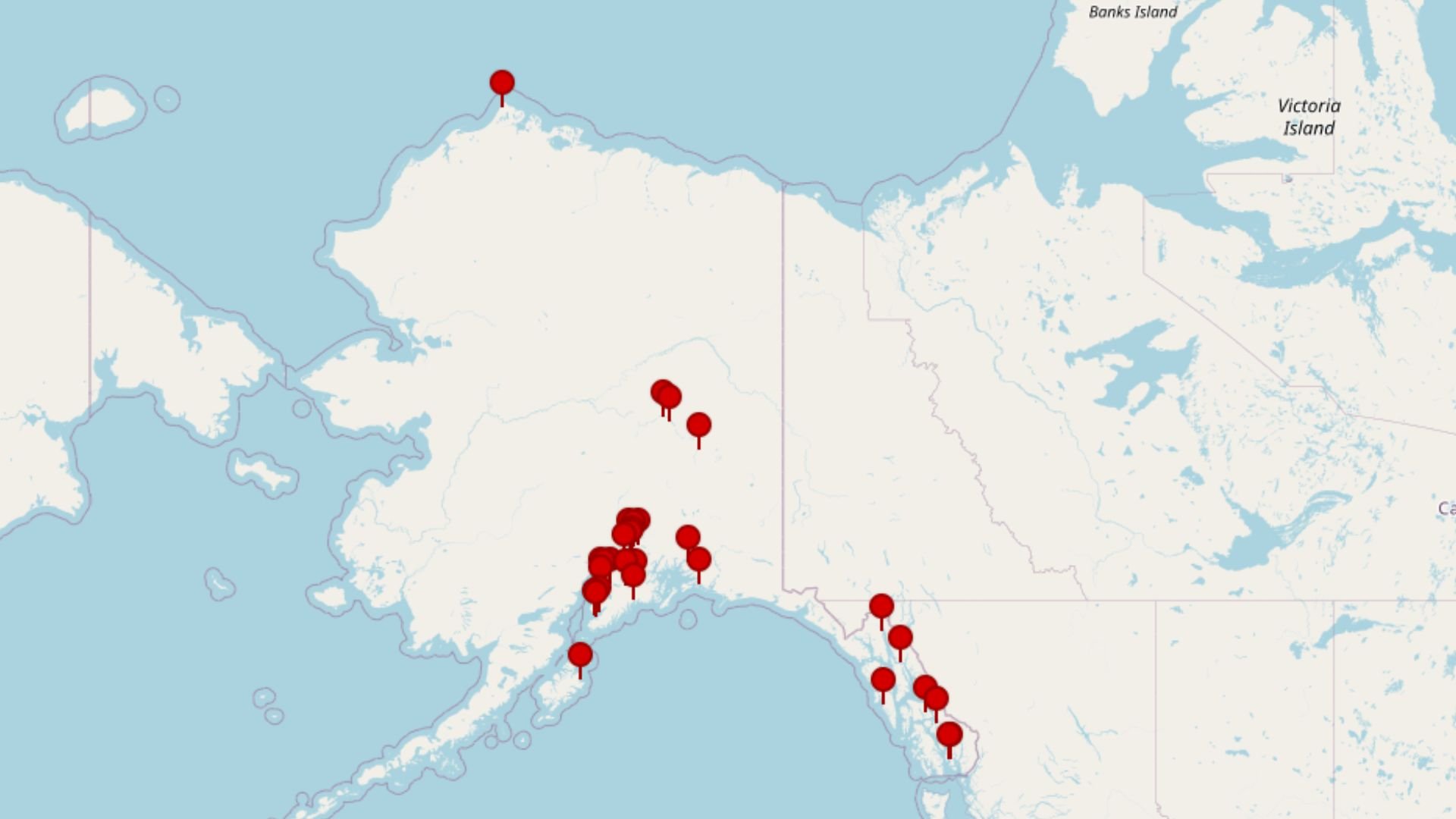
Using the latest Zillow Home Value Index data, we’ve identified the 30 most expensive towns in Alaska based on current home prices. These communities represent some of America’s most remote yet desirable real estate markets, where pristine wilderness meets serious investment value. From coastal fishing villages accessible only by plane to thriving suburbs near major cities, each town shows how location, resources, and lifestyle can drive remarkable price appreciation even in the far north.
Price increases across these communities range from modest single-digit gains to explosive jumps exceeding 90% over different time periods. Whether you’re considering a move to the Last Frontier, exploring investment opportunities, or simply curious about where Alaska’s housing market commands premium prices, this ranking reveals the forces shaping real estate in America’s largest state.
30. Moose Pass – 78% Home Price Increase Since 2012
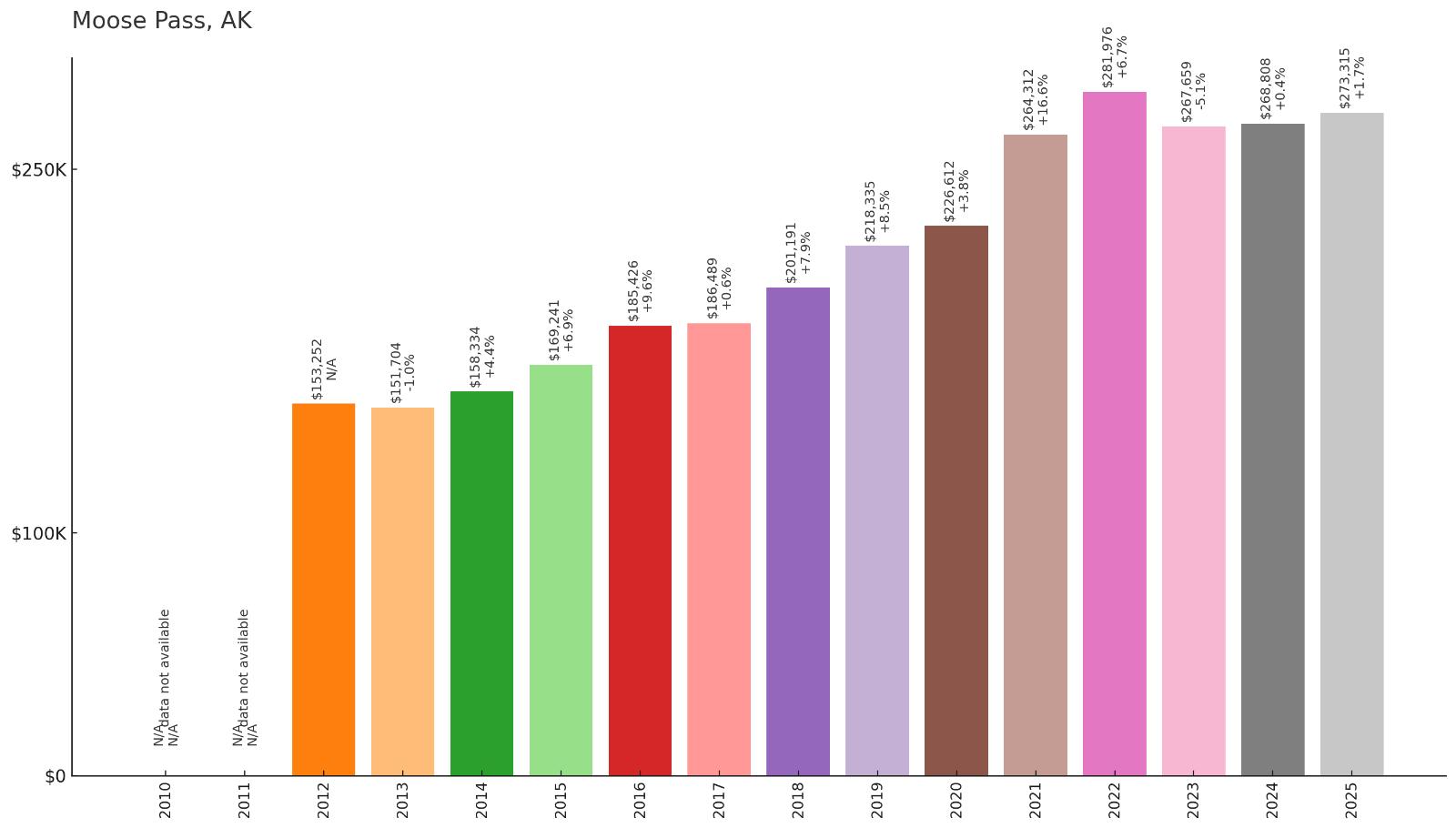
- 2010: N/A
- 2011: N/A
- 2012: $153,252
- 2013: $151,704
- 2014: $158,334
- 2015: $169,241
- 2016: $185,426
- 2017: $186,489
- 2018: $201,191
- 2019: $218,335
- 2020: $226,612
- 2021: $264,312
- 2022: $281,976
- 2023: $267,659
- 2024: $268,808
- 2025: $273,315
Moose Pass has shown steady growth since data became available in 2012, with values climbing from around $153,000 to over $273,000. The community experienced its strongest surge during the pandemic housing boom of 2020-2022, adding nearly $57,000 in value during that period. Current prices reflect stabilization after the 2022 peak, with modest but consistent gains continuing into 2025.
Why Moose Pass?

Why Are People Willing to Pay So Much to Live Here? What’s Special About It?
Moose Pass attracts residents with its quintessential small-town Alaska charm and prime location on the Kenai Peninsula. The community sits along the scenic Seward Highway, offering easy access to world-class fishing, hiking, and outdoor recreation that defines the Alaska lifestyle. Families appreciate the tight-knit community feel, where neighbors know each other and children can experience true wilderness living.
The town’s location provides the perfect balance of remoteness and accessibility, sitting roughly halfway between Anchorage and Seward. Property owners enjoy stunning mountain and lake views while maintaining reasonable access to larger communities for work and services. The area’s limited development and zoning restrictions help preserve the rural character that makes it so appealing to those seeking authentic Alaska living.
How Moose Pass Rose to Prominence
Moose Pass began as a railroad construction camp in the early 1900s during the building of the Alaska Railroad. The town got its name from a narrow mountain pass where moose were often seen crossing between lakes. For decades, it remained a small railroad maintenance stop and fishing outpost along Trail Lake.
The community’s growth accelerated when the Seward Highway was completed, making it accessible by car and positioning it as a gateway to the Kenai Peninsula’s recreational opportunities. As Alaska’s tourism industry expanded and more people discovered the peninsula’s fishing and outdoor attractions, Moose Pass became an attractive location for vacation homes and permanent residents seeking small-town mountain living.
3 Interesting Tidbits
1. Railroad Heritage – The town still maintains its historic railroad depot, which serves as a community center and reminder of its origins as a construction camp.
2. Summer Solstice Festival – Moose Pass hosts an annual Summer Solstice Festival that draws visitors from across Alaska to celebrate the longest day of the year with local music and food.
3. Trail Lake Connection – The community sits on the shores of Trail Lake, which offers excellent grayling fishing and serves as a popular stopover for travelers heading to Seward.
29. Kasilof – 68% Home Price Increase Since 2010
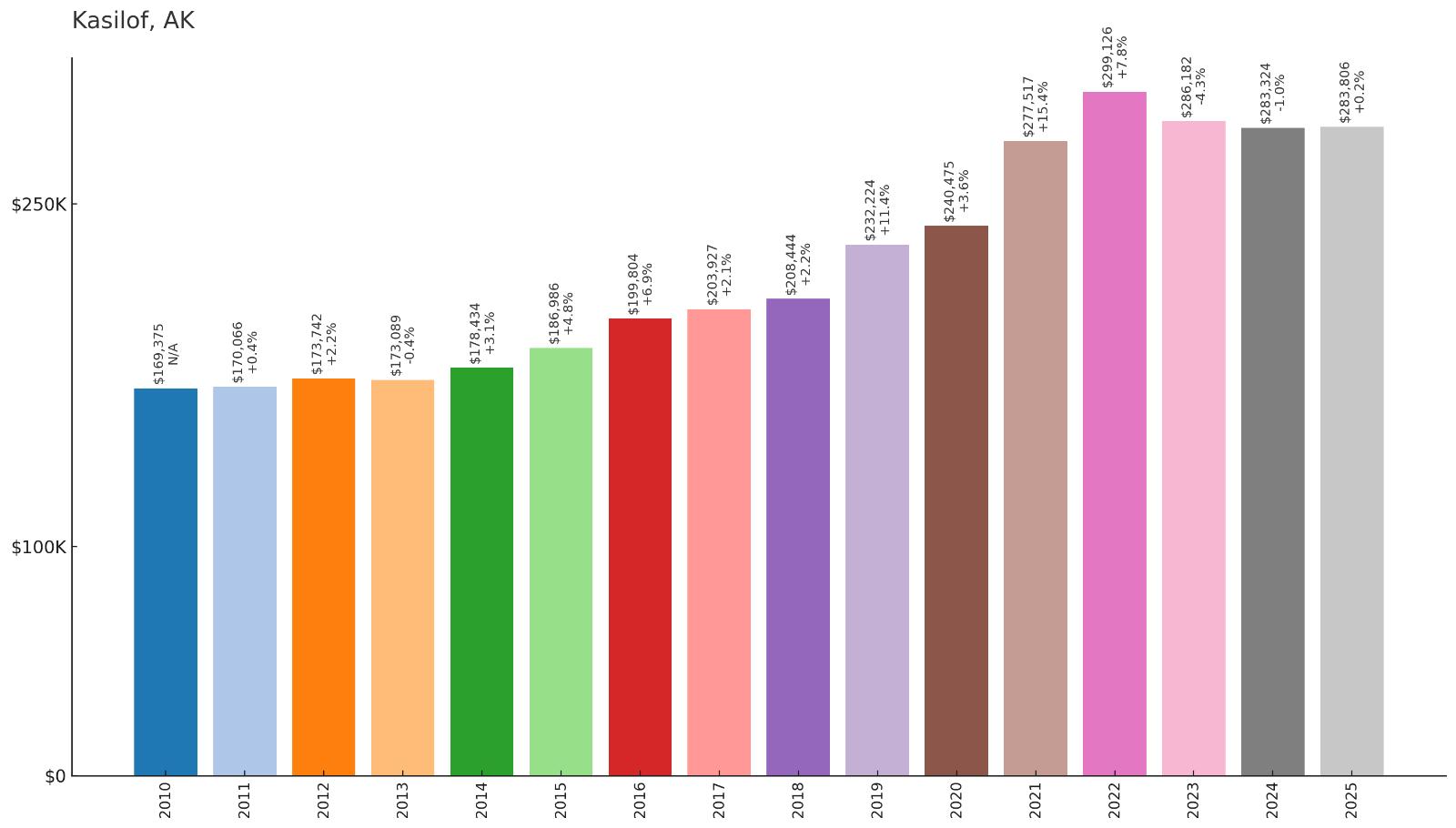
- 2010: $169,375
- 2011: $170,066
- 2012: $173,742
- 2013: $173,089
- 2014: $178,434
- 2015: $186,986
- 2016: $199,804
- 2017: $203,927
- 2018: $208,444
- 2019: $232,224
- 2020: $240,475
- 2021: $277,517
- 2022: $299,126
- 2023: $286,182
- 2024: $283,324
- 2025: $283,806
Kasilof has demonstrated consistent appreciation over the past 15 years, with values climbing steadily from $169,375 in 2010 to $283,806 in 2025. The community saw its strongest growth during the pandemic period, particularly in 2021-2022 when values jumped significantly. Recent years show some cooling from the 2022 peak, but prices remain well above historical levels.
Why Kasilof?

Why Are People Willing to Pay So Much to Live Here? What’s Special About It?
Kasilof draws residents with its exceptional fishing opportunities along the famous Kasilof River, known for producing world-class salmon runs that attract anglers from around the globe. The community offers a perfect blend of rural living and coastal access, with many properties featuring river or beach frontage along Cook Inlet. Residents enjoy the peaceful, uncrowded lifestyle that comes with small-town Alaska living.
The area’s agricultural potential sets it apart from many Alaska communities, with longer growing seasons and fertile soils that support farming operations. Property owners can pursue self-sufficient living with gardens, livestock, and hunting opportunities right outside their doors. The community’s location provides easy access to both Soldotna’s services and Anchorage’s employment opportunities.
How Kasilof Rose to Prominence
Kasilof’s history stretches back to Russian colonial times when it served as an agricultural settlement along Cook Inlet. The area’s fertile soils and relatively mild climate made it an ideal location for farming operations that supplied Russian settlements and trading posts. The community’s name comes from a Russian word meaning “place of many fish.”
The modern community developed around homesteading opportunities in the mid-20th century, when Alaska opened lands for agricultural settlement. The completion of the Sterling Highway connected Kasilof to the road system, making it accessible while preserving its rural character. The area’s reputation for excellent salmon fishing and hunting helped establish it as a destination for outdoor enthusiasts and permanent residents seeking the Alaska lifestyle.
3 Interesting Tidbits
1. Historic Church – The Kasilof area is home to one of Alaska’s oldest Russian Orthodox churches, reflecting the community’s colonial heritage.
2. Agricultural Legacy – Unlike many Alaska communities, Kasilof has maintained active farming operations, including cattle ranches and vegetable farms that supply local markets.
3. Clam Capital – The nearby beaches are famous for razor clam digging, earning the area a reputation as one of Alaska’s best clamming destinations.
28. Fairbanks – 31% Home Price Increase Since 2010

- 2010: $220,565
- 2011: $220,194
- 2012: $220,938
- 2013: $220,541
- 2014: $216,692
- 2015: $221,888
- 2016: $230,048
- 2017: $238,748
- 2018: $245,767
- 2019: $261,753
- 2020: $268,763
- 2021: $278,454
- 2022: $295,905
- 2023: $289,540
- 2024: $292,869
- 2025: $288,095
Fairbanks has experienced moderate but steady growth since 2010, with values rising from $220,565 to $288,095 over 15 years. The city showed remarkable stability through the early 2010s before beginning consistent appreciation around 2016. Growth accelerated during the pandemic years, though recent data suggests some cooling from 2022 peaks.
Why Fairbanks?

Why Are People Willing to Pay So Much to Live Here? What’s Special About It?
Fairbanks attracts residents as Alaska’s Interior hub, offering urban amenities while maintaining access to vast wilderness areas. The city serves as the economic and cultural center for much of Alaska’s Interior, providing job opportunities in government, education, military, and resource extraction industries. Residents enjoy four distinct seasons, including spectacular Northern Lights displays during long winter nights.
The community offers excellent educational opportunities through the University of Alaska Fairbanks, which brings cultural events, research opportunities, and a diverse population to the area. Military installations provide stable employment and contribute to the local economy. The city’s infrastructure and services are well-developed compared to many Alaska communities, while still offering easy access to hunting, fishing, and outdoor recreation.
How Fairbanks Rose to Prominence
Fairbanks was founded in 1901 as a gold rush town when prospector Felix Pedro discovered gold in nearby creeks. The community quickly became the supply hub for Interior Alaska mining operations, with steamboats bringing goods up the Chena and Tanana Rivers. The town was named after Senator Charles Fairbanks, who later became Vice President under Theodore Roosevelt.
World War II transformed Fairbanks from a mining town into a military strategic location, with the Alaska Highway connecting it to the continental United States. The establishment of military bases and the University of Alaska diversified the economy beyond mining. The Trans-Alaska Pipeline construction in the 1970s brought another economic boom, cementing Fairbanks’ role as Interior Alaska’s primary city.
3 Interesting Tidbits
1. Aurora Research – Fairbanks is one of the world’s best locations for Northern Lights viewing and aurora research, attracting scientists and tourists from around the globe.
2. Temperature Extremes – The city experiences some of North America’s most extreme temperature swings, from summer highs near 90°F to winter lows approaching -60°F.
3. Dog Mushing Capital – Fairbanks is the official start and finish of the Yukon Quest International Sled Dog Race and maintains strong dog mushing traditions year-round.
27. Saxman – 63% Home Price Increase Since 2012

- 2010: N/A
- 2011: N/A
- 2012: $177,691
- 2013: $177,212
- 2014: $190,132
- 2015: $206,229
- 2016: $209,883
- 2017: $215,366
- 2018: $227,572
- 2019: $234,937
- 2020: $245,814
- 2021: $268,798
- 2022: $285,231
- 2023: $284,947
- 2024: $271,116
- 2025: $289,723
Saxman has achieved steady appreciation since data became available in 2012, with home values climbing from under $178,000 to nearly $290,000. The community experienced consistent growth through the 2010s, with notable acceleration during the pandemic housing boom of 2020-2022. After a brief dip in 2024, values have rebounded strongly to reach new highs in 2025.
Why Saxman?

Why Are People Willing to Pay So Much to Live Here? What’s Special About It?
Saxman offers unique cultural significance as an Alaska Native village just minutes from Ketchikan’s amenities and services. The community is renowned for its exceptional collection of totem poles and traditional Tlingit cultural sites that attract visitors from around the world. Residents enjoy small-town community connections while having easy access to Ketchikan’s employment opportunities, healthcare, and transportation links.
The village maintains strong traditional values and cultural practices while offering modern conveniences and infrastructure improvements. Properties often feature stunning views of the Inside Passage waters and surrounding temperate rainforest. The community’s proximity to Ketchikan provides urban conveniences without sacrificing the peaceful, culturally rich lifestyle that defines rural Southeast Alaska.
How Saxman Rose to Prominence
Saxman was established in 1894 as a Presbyterian mission and Native village, named after missionary Samuel Saxman who worked with the local Tlingit community. The village was created as part of efforts to provide education and services to Alaska Native families in the Ketchikan area. Traditional Tlingit families relocated to Saxman from various camps and villages throughout Southeast Alaska.
The community gained prominence through its commitment to preserving and sharing Tlingit culture, particularly through the restoration and display of historic totem poles. During the 1930s, the Civilian Conservation Corps helped restore many totems that had been moved from abandoned village sites. This cultural preservation work established Saxman as an important center for Native heritage and education.
3 Interesting Tidbits
1. Totem Park – Saxman houses one of the world’s largest collections of standing totem poles, with 24 restored totems representing different Tlingit clans and stories.
2. Carving Center – The village operates an active carving center where traditional artists create and teach totem pole carving, keeping ancient skills alive for new generations.
3. Cultural Performances – Saxman hosts regular traditional dance performances and cultural demonstrations that share Tlingit history and customs with visitors and residents.
26. Wrangell – 45% Home Price Increase Since 2016
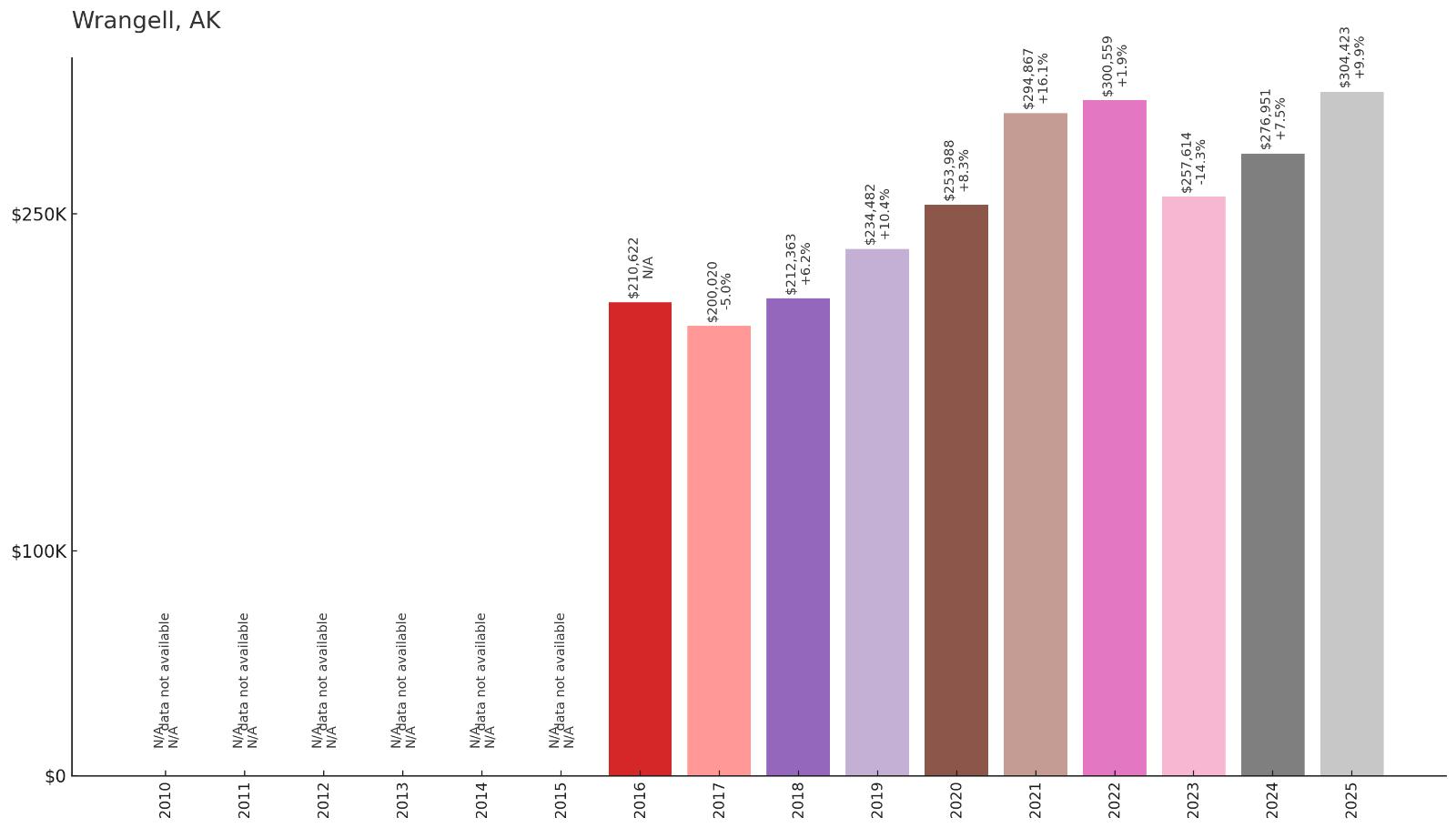
- 2010: N/A
- 2011: N/A
- 2012: N/A
- 2013: N/A
- 2014: N/A
- 2015: N/A
- 2016: $210,622
- 2017: $200,020
- 2018: $212,363
- 2019: $234,482
- 2020: $253,988
- 2021: $294,867
- 2022: $300,559
- 2023: $257,614
- 2024: $276,951
- 2025: $304,423
Wrangell has shown volatile but ultimately strong growth since data became available in 2016. After an initial dip in 2017, values have climbed significantly, particularly during the 2019-2022 period when prices jumped substantially. Despite some fluctuation, the current value of $304,423 represents solid appreciation from the 2016 baseline of $210,622.
Why Wrangell?

Why Are People Willing to Pay So Much to Live Here? What’s Special About It?
Wrangell attracts residents with its remarkable fishing opportunities and stunning natural setting on the Stikine River delta. The community provides access to some of Alaska’s most productive salmon runs and offers excellent hunting for deer, bear, and moose. Residents appreciate the small-town atmosphere where community connections run deep and outdoor activities define daily life.
The town’s location provides unique access to the Stikine River system, allowing boat access deep into British Columbia’s wilderness areas. Property owners enjoy waterfront opportunities and views while maintaining services like schools, healthcare, and air transportation. The community’s timber industry heritage and ongoing natural resource activities provide employment opportunities beyond tourism and fishing.
How Wrangell Rose to Prominence
Wrangell has the distinction of being Alaska’s oldest incorporated city, with a history stretching back to Tlingit settlements and Russian fort construction in the 1830s. The town was strategically located to control access to the Stikine River, making it important for fur trading and later gold rush activities. Both Russian and British forces recognized its value as a trading post and military position.
The community’s prominence grew during multiple gold rushes when it served as a supply point for miners heading up the Stikine River to Canadian goldfields. Later, timber became the economic backbone, with large-scale logging operations supporting the community for much of the 20th century. The town’s deep-water port and airport made it a regional hub for Southeast Alaska communities.
3 Interesting Tidbits
1. Triple Flag Heritage – Wrangell is the only Alaska city to have been under four different flags: Tlingit, Russian, British, and American control.
2. Petroglyph Beach – The community features an ancient beach covered with Native petroglyphs, some estimated to be over 8,000 years old.
3. Garnet Ledge – Wrangell children have exclusive rights to collect and sell garnets from a nearby ledge, a tradition dating back to the early 1900s.
25. Barrow – 97% Home Price Increase Since 2016
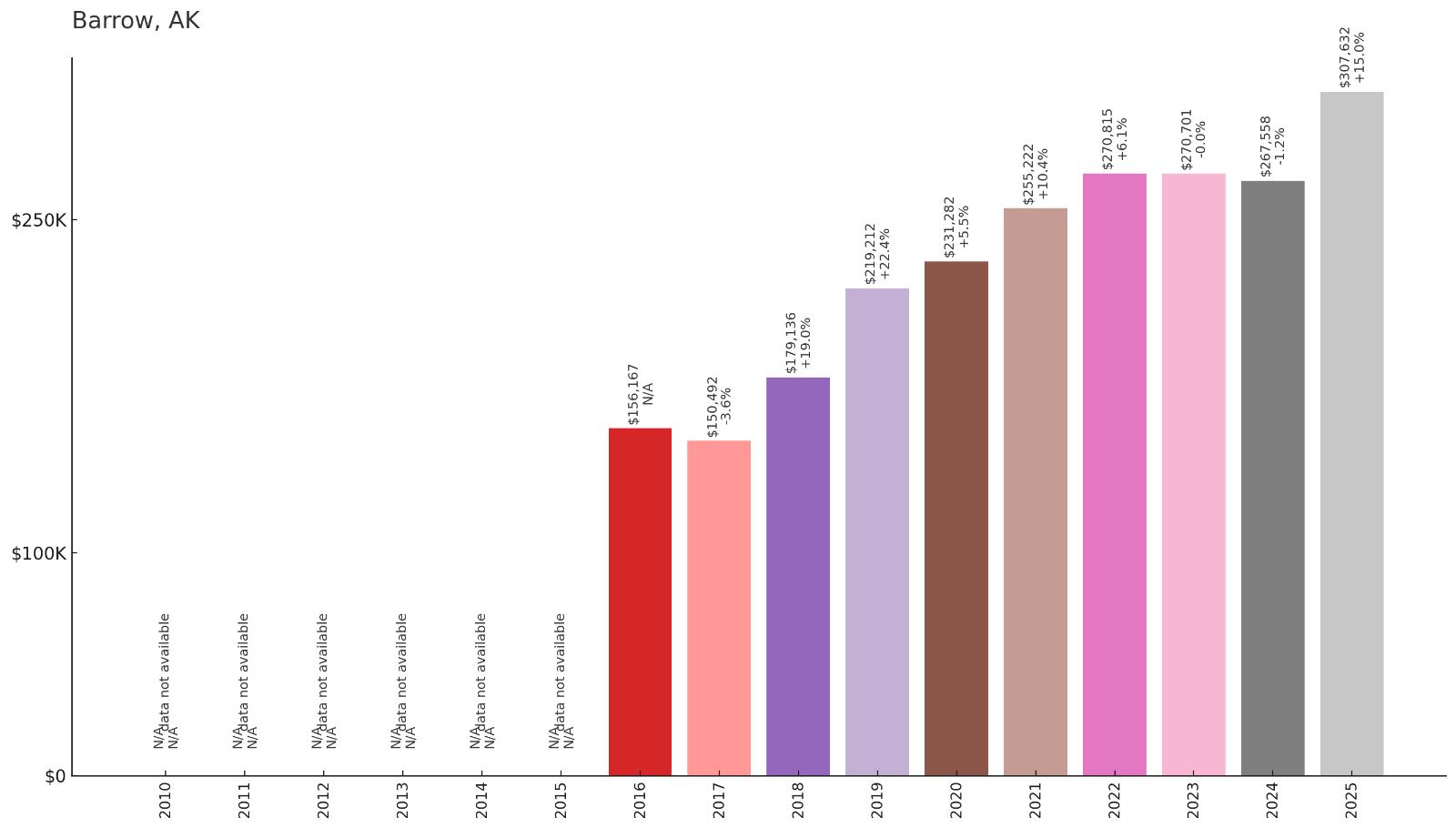
- 2010: N/A
- 2011: N/A
- 2012: N/A
- 2013: N/A
- 2014: N/A
- 2015: N/A
- 2016: $156,167
- 2017: $150,492
- 2018: $179,136
- 2019: $219,212
- 2020: $231,282
- 2021: $255,222
- 2022: $270,815
- 2023: $270,701
- 2024: $267,558
- 2025: $307,632
Barrow has demonstrated explosive growth since data collection began in 2016, nearly doubling in value from $156,167 to $307,632. After an initial dip in 2017, the community has shown remarkable appreciation, particularly accelerating from 2018 onward. The 2025 surge to over $307,000 represents exceptional performance in America’s northernmost community.
Why Barrow?

Why Are People Willing to Pay So Much to Live Here? What’s Special About It?
Barrow attracts residents with its unique position as America’s northernmost community and the economic opportunities that come with oil industry operations. The town offers high-paying jobs in petroleum extraction, municipal services, and support industries that serve the North Slope oil fields. Workers appreciate the 2-week on, 2-week off schedules common in oil work, allowing extended time off for travel or family.
The community provides a truly unique living experience, with months of continuous daylight in summer and extended darkness in winter. Residents form tight community bonds and enjoy subsistence hunting and whaling traditions that connect them to Iñupiaq culture. Despite the extreme climate, modern infrastructure provides comfortable housing, utilities, and services year-round.
How Barrow Rose to Prominence
Barrow (officially renamed Utqiagvik in 2016) has been inhabited by Iñupiaq people for over 1,000 years, serving as a whaling and trading center in the Arctic. The modern town developed around a meteorological station established in the early 20th century and grew significantly during World War II when military operations required Arctic bases.
The community’s transformation accelerated with oil discoveries on Alaska’s North Slope in the 1960s, making it a crucial logistical hub for petroleum operations. The construction of the Trans-Alaska Pipeline and ongoing oil development created high-paying employment opportunities. Despite its remote location, Barrow became one of Alaska’s wealthiest communities due to oil revenues and the North Slope Borough’s tax base.
3 Interesting Tidbits
1. Polar Night – Barrow experiences 65 consecutive days of darkness each winter, with the sun setting in November and not rising again until January.
2. Whaling Tradition – The community maintains active bowhead whale hunting traditions, with successful hunts providing food for the entire community through ancient sharing customs.
3. Research Hub – Barrow hosts major Arctic research facilities studying climate change, ice conditions, and polar ecosystems, attracting scientists from around the world.
24. Kenai – 57% Home Price Increase Since 2010
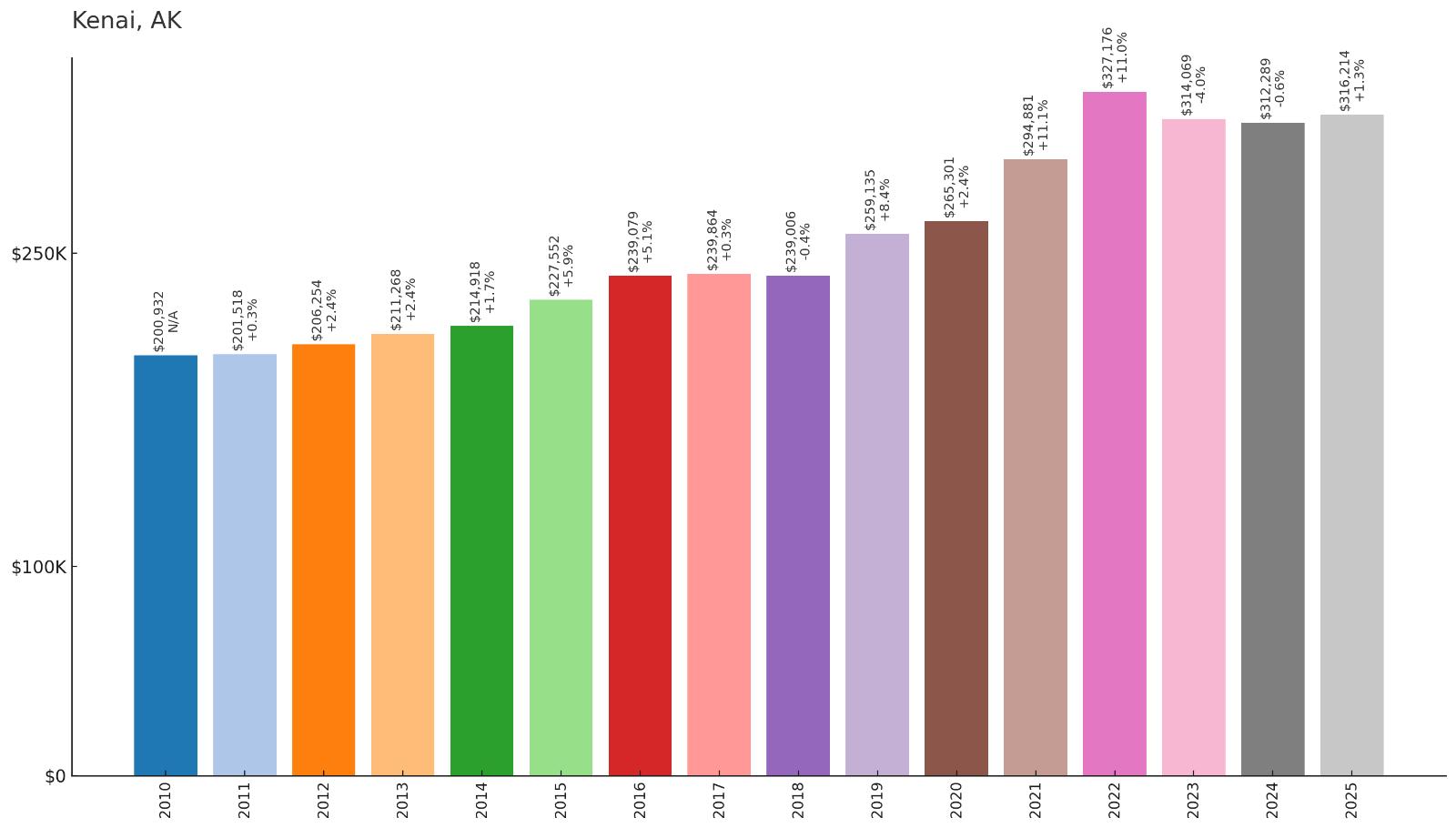
- 2010: $200,932
- 2011: $201,518
- 2012: $206,254
- 2013: $211,268
- 2014: $214,918
- 2015: $227,552
- 2016: $239,079
- 2017: $239,864
- 2018: $239,006
- 2019: $259,135
- 2020: $265,301
- 2021: $294,881
- 2022: $327,176
- 2023: $314,069
- 2024: $312,289
- 2025: $316,214
Kenai has shown consistent appreciation since 2010, with values climbing steadily from just over $200,000 to more than $316,000. The community experienced steady but modest growth through the 2010s before accelerating significantly during 2019-2022. Recent years show some stabilization from pandemic peaks, but prices remain well above historical levels.
Why Kenai?
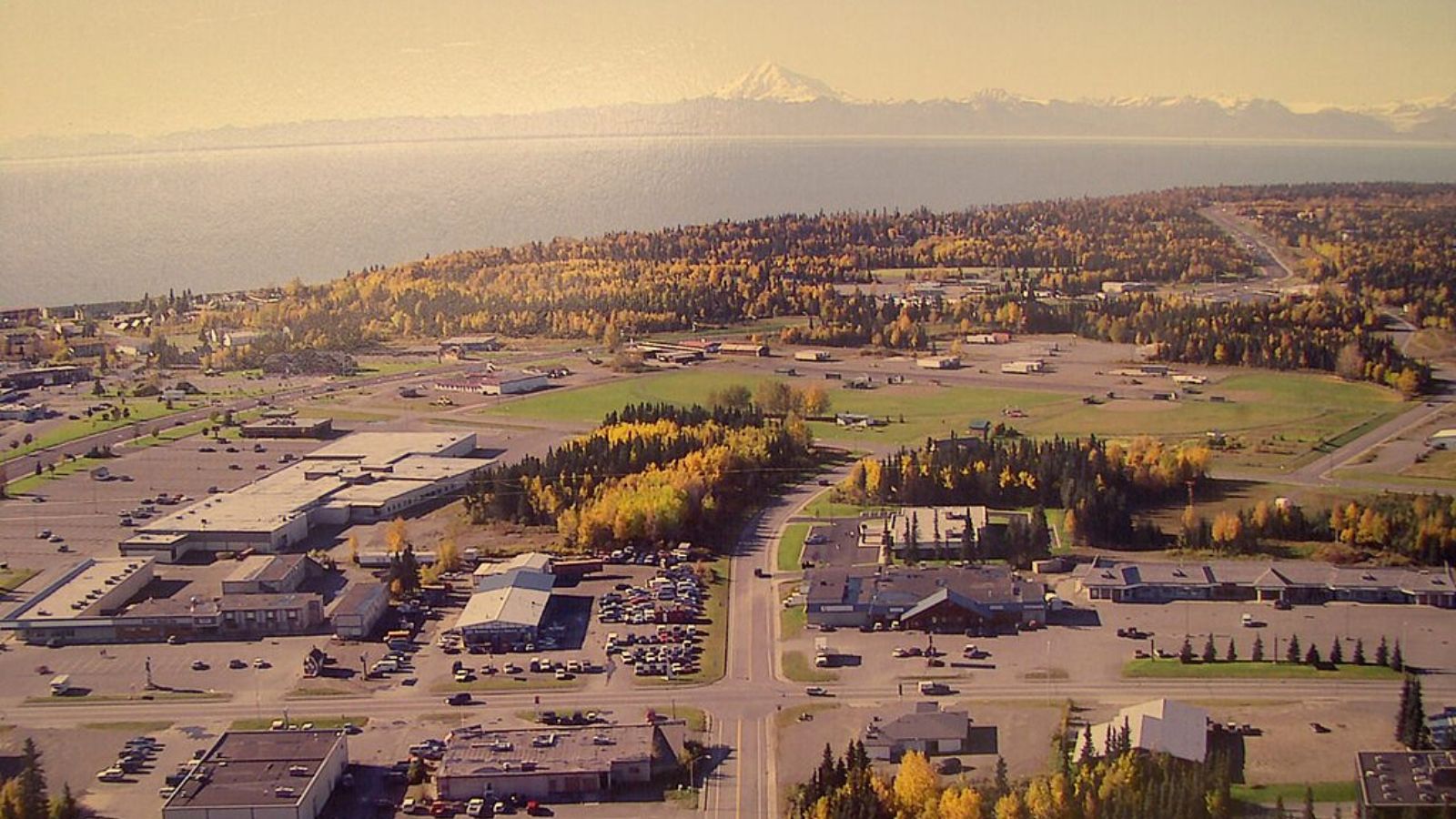
Why Are People Willing to Pay So Much to Live Here? What’s Special About It?
Kenai draws residents with its prime location at the mouth of the world-famous Kenai River, offering unparalleled fishing opportunities for salmon, trout, and other species. The community provides an ideal balance of small-town living with access to outdoor recreation that defines the Alaska lifestyle. Residents enjoy both the tourist economy’s benefits and the area’s natural beauty without the crowds of more accessible destinations.
The city offers well-developed infrastructure including schools, healthcare, and commercial services while maintaining easy access to wilderness areas. Property owners appreciate the area’s relatively mild climate by Alaska standards and the extended summer growing season. The community’s central location on the Kenai Peninsula provides access to multiple recreational areas and employment opportunities.
How Kenai Rose to Prominence
Kenai is one of Alaska’s oldest settlements, with roots tracing back to Dena’ina Athabascan people who lived in the area for thousands of years. Russian fur traders established a post here in 1791, making it one of Alaska’s first European settlements. The community’s strategic location at the Kenai River mouth made it important for trade and salmon fishing.
The modern city developed during Alaska’s homesteading era and grew significantly with oil discoveries in Cook Inlet during the 1950s and 1960s. The discovery of oil offshore brought economic development and population growth. Tourism related to world-class salmon fishing, particularly king salmon runs, established Kenai as a premier destination for anglers worldwide, supporting a thriving service economy.
3 Interesting Tidbits
1. Russian Heritage – Kenai maintains Alaska’s oldest Russian Orthodox parish, with Holy Assumption Church dating back to the 1890s and serving the community continuously.
2. King Salmon Capital – The Kenai River is famous for producing world-record king salmon, with the current record holder weighing over 97 pounds caught in 1985.
3. Oil Revenue – Cook Inlet oil production has provided significant tax revenue to the community, funding infrastructure and services far beyond what the population would normally support.
23. North Pole – 33% Home Price Increase Since 2010
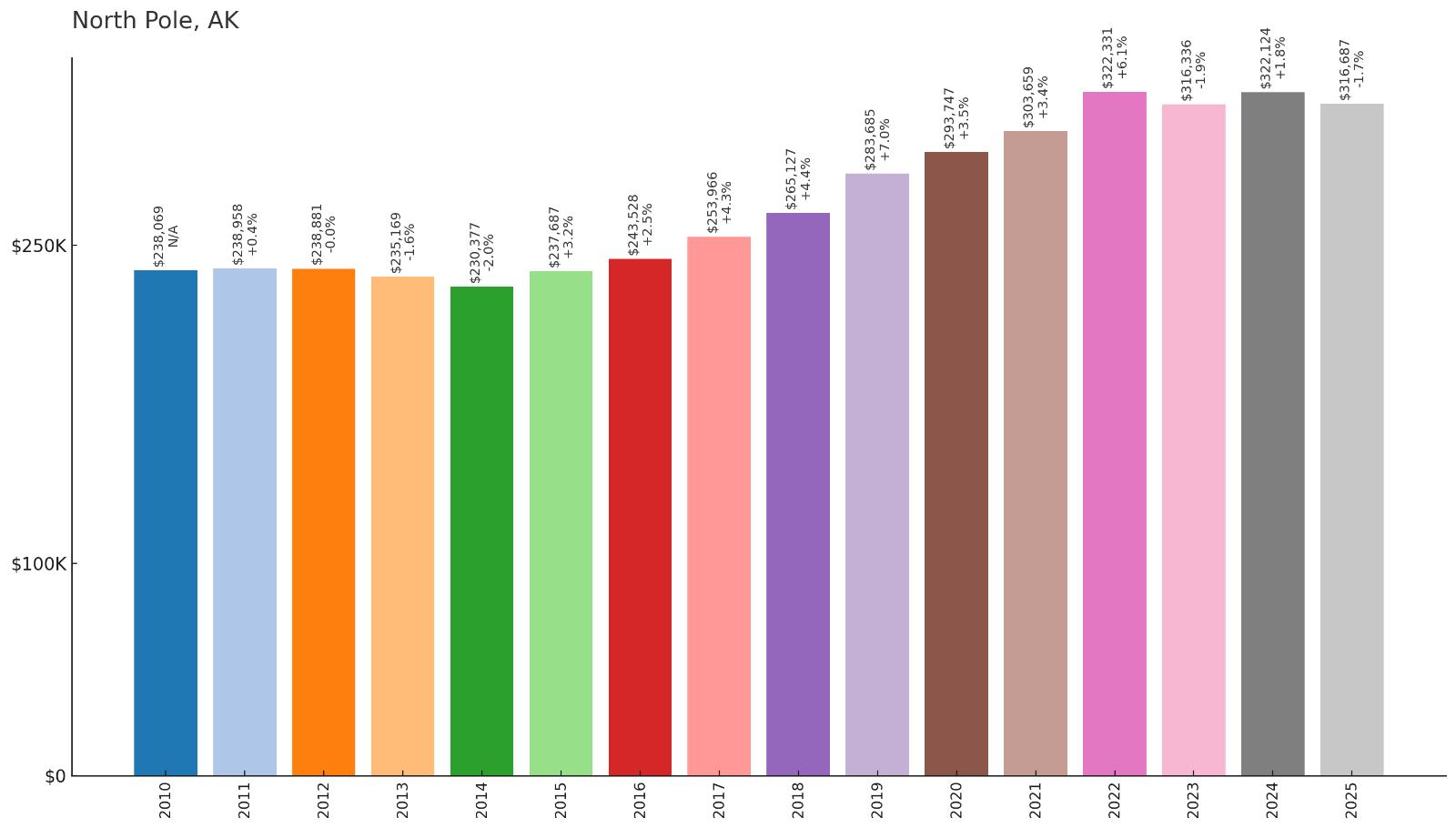
- 2010: $238,069
- 2011: $238,958
- 2012: $238,881
- 2013: $235,169
- 2014: $230,377
- 2015: $237,687
- 2016: $243,528
- 2017: $253,966
- 2018: $265,127
- 2019: $283,685
- 2020: $293,747
- 2021: $303,659
- 2022: $322,331
- 2023: $316,336
- 2024: $322,124
- 2025: $316,687
North Pole has demonstrated steady growth patterns over 15 years, with values rising from $238,069 in 2010 to $316,687 in 2025. The community showed remarkable stability through the early 2010s before beginning consistent appreciation around 2016. Growth accelerated during recent years, though the market has shown some cooling from 2022 peaks.
Why North Pole?

Why Are People Willing to Pay So Much to Live Here? What’s Special About It?
North Pole attracts residents seeking suburban living with easy access to Fairbanks employment opportunities while maintaining small-town character. The community offers family-friendly neighborhoods with good schools and recreational facilities, appealing to those who want the benefits of the Fairbanks job market without city living. Residents enjoy the Christmas theme that makes the town unique while accessing urban amenities just 14 miles away.
The area provides affordable housing options compared to Fairbanks proper while offering larger lots and newer subdivisions. Military families appreciate the community’s proximity to military installations while enjoying civilian community life. The town’s infrastructure and services are well-maintained, providing reliable utilities and municipal services despite Interior Alaska’s challenging climate conditions.
How North Pole Rose to Prominence
North Pole was founded in the 1950s as a planned community designed to attract businesses with its festive name and Christmas theme. The developers hoped the name would attract toy manufacturers and other Christmas-related industries, though this vision never fully materialized. Instead, the community grew as a suburb of nearby Fairbanks.
The town’s growth accelerated during the Trans-Alaska Pipeline construction boom of the 1970s when workers and support personnel needed housing near Fairbanks. The community embraced its Christmas identity with themed street names, decorations, and the famous Santa Claus House attraction. Military expansion at nearby bases provided additional population growth and economic stability.
3 Interesting Tidbits
1. Santa’s Post Office – The local post office receives hundreds of thousands of letters addressed to Santa Claus each year, with volunteers responding to many children’s letters.
2. Christmas Street Names – Streets have festive names like Santa Claus Lane, Kris Kringle Drive, and Mistletoe Lane, maintaining the Christmas theme throughout the community.
3. Refinery Operations – Despite its whimsical name, North Pole is home to major industrial operations including Petro Star’s oil refinery, one of Alaska’s largest.
22. Diamond Ridge – 72% Home Price Increase Since 2010

- 2010: $188,209
- 2011: $187,559
- 2012: $197,658
- 2013: $201,490
- 2014: $207,662
- 2015: $214,594
- 2016: $217,677
- 2017: $220,119
- 2018: $231,391
- 2019: $252,206
- 2020: $263,252
- 2021: $308,159
- 2022: $329,989
- 2023: $311,030
- 2024: $319,150
- 2025: $323,216
Diamond Ridge has achieved strong appreciation since 2010, with values climbing from $188,209 to $323,216 over 15 years. The community maintained steady but moderate growth through the 2010s before experiencing significant acceleration during the pandemic years of 2020-2022. Recent data shows continued strength with values remaining well above pre-pandemic levels.
Why Diamond Ridge?

Why Are People Willing to Pay So Much to Live Here? What’s Special About It?
Diamond Ridge attracts residents with its elevated location offering spectacular views of Cook Inlet, the Alaska Range, and Denali on clear days. The community provides a rural residential setting with larger lots and custom homes while maintaining reasonable access to Anchorage employment opportunities. Families appreciate the small-town atmosphere, excellent schools, and outdoor recreation opportunities right outside their doors.
The area offers a perfect balance of privacy and community, with neighborhood connections but plenty of space for personal pursuits like gardening, workshops, or small-scale farming. Property owners enjoy the area’s slightly warmer microclimate and longer growing season compared to other parts of south-central Alaska. The community’s careful development has preserved much of the natural character while providing modern amenities and services.
How Diamond Ridge Rose to Prominence
Diamond Ridge developed as part of the broader Anchorage suburban expansion during Alaska’s oil boom years of the 1970s and 1980s. The area’s elevated terrain and scenic views made it attractive for residential development as families sought alternatives to city living while maintaining access to Anchorage jobs. Early development focused on larger lots that appealed to those wanting space and privacy.
The community grew steadily as Anchorage’s metropolitan area expanded and residents sought suburban alternatives with better schools and more space. The area’s location along major transportation corridors made commuting feasible while preserving the rural residential character. Careful zoning and development standards helped maintain property values and the area’s desirable living environment.
3 Interesting Tidbits
1. Mountain Views – On clear days, residents can see Denali (Mount McKinley) from their properties, one of the few residential areas in Alaska with views of North America’s tallest peak.
2. Growing Season – The area’s slightly elevated location and southern exposure create a favorable microclimate that extends the growing season for gardens and landscaping.
3. Wildlife Corridor – Despite residential development, the area maintains important wildlife corridors that allow moose, bears, and other animals to move through the community safely.
21. Haines – 11% Home Price Increase Since 2021
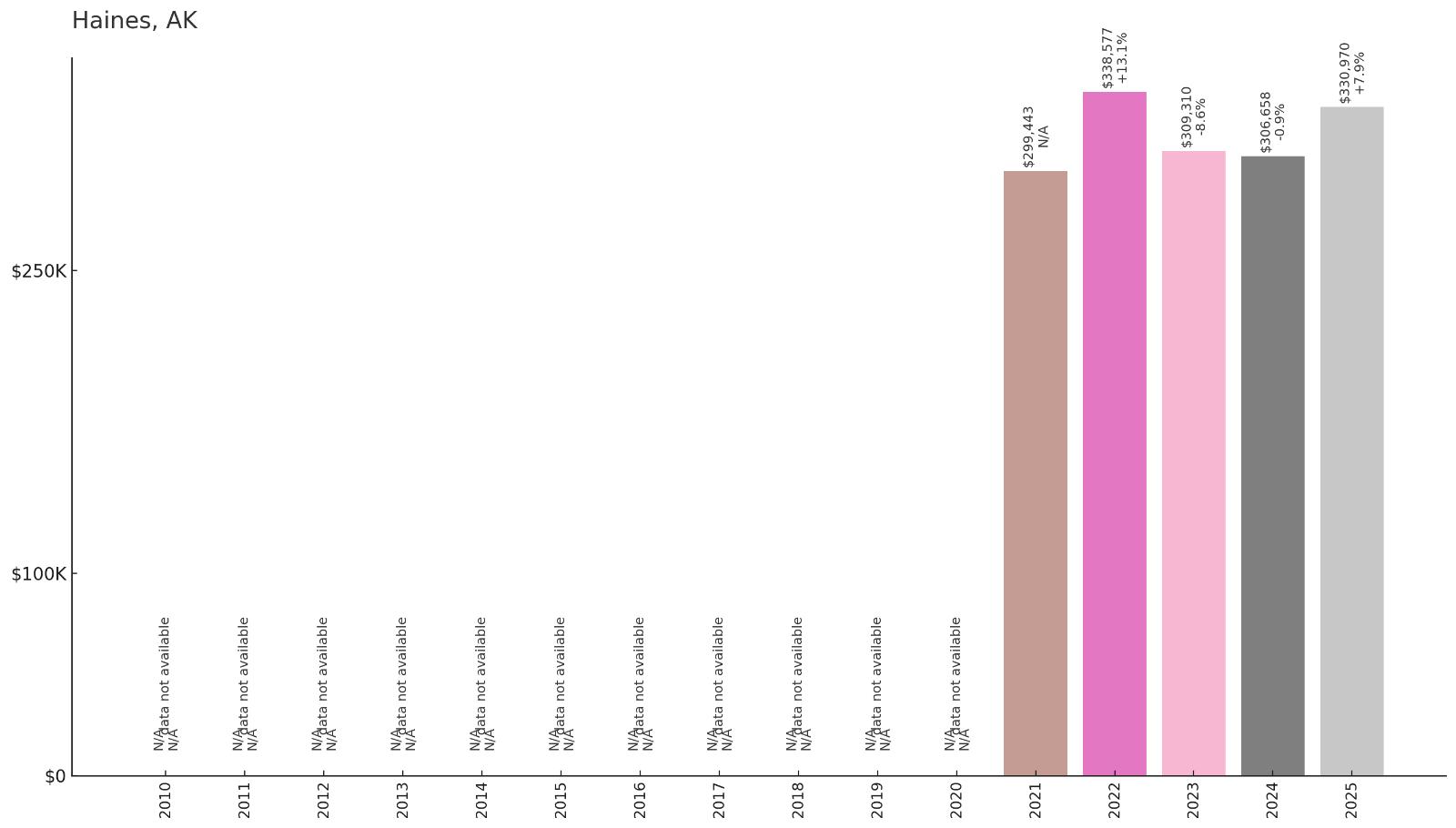
- 2010: N/A
- 2011: N/A
- 2012: N/A
- 2013: N/A
- 2014: N/A
- 2015: N/A
- 2016: N/A
- 2017: N/A
- 2018: N/A
- 2019: N/A
- 2020: N/A
- 2021: $299,443
- 2022: $338,577
- 2023: $309,310
- 2024: $306,658
- 2025: $330,970
Haines has limited data available starting from 2021, but shows moderate appreciation over the short time period tracked. Values jumped significantly in 2022 before cooling somewhat in 2023-2024, then rebounding in 2025. The current value of $330,970 represents solid growth from the initial 2021 baseline of $299,443.
Why Haines?

Why Are People Willing to Pay So Much to Live Here? What’s Special About It?
Haines attracts residents with its stunning location at the northern end of the Inside Passage, surrounded by dramatic mountains and pristine waters. The community offers exceptional outdoor recreation opportunities including world-class fishing, hunting, hiking, and wildlife viewing in one of Alaska’s most scenic settings. Residents appreciate the small-town atmosphere where community connections are strong and the pace of life remains unhurried.
The town provides unique access to both marine and interior Alaska environments, with the Chilkat River system offering excellent salmon fishing and the surrounding mountains providing hunting and hiking opportunities. Property owners enjoy waterfront access and mountain views while maintaining essential services including schools, healthcare, and transportation connections. The area’s arts community and cultural events add richness to daily life.
How Haines Rose to Prominence
Haines was established as a Presbyterian mission in 1881, named after the mission’s founding secretary. The community grew around the mission and became an important trading post serving both Tlingit communities and prospectors heading to interior goldfields. The completion of the Chilkoot Trail made Haines a gateway to the Klondike gold rush.
During World War II, Haines gained strategic importance when the military constructed the Haines Highway connecting the community to the Alaska Highway system. This road connection distinguished Haines from most Southeast Alaska communities and made it accessible by vehicle. The combination of marine access and road connections helped establish Haines as a regional transportation and supply hub.
3 Interesting Tidbits
1. Bald Eagle Gathering – Each fall, the Chilkat River hosts one of the world’s largest gatherings of bald eagles, with thousands of birds congregating to feed on late salmon runs.
2. Road Connected – Unlike most Southeast Alaska communities, Haines is connected to the continental road system via the Haines Highway, making it accessible by car year-round.
3. Arts Community – The town maintains an active arts scene with galleries, studios, and the annual Southeast Alaska State Fair that draws visitors from throughout the region.
20. Sterling – 75% Home Price Increase Since 2010

- 2010: $192,406
- 2011: $194,851
- 2012: $202,679
- 2013: $200,890
- 2014: $206,306
- 2015: $216,398
- 2016: $227,915
- 2017: $234,145
- 2018: $239,178
- 2019: $260,955
- 2020: $269,574
- 2021: $306,732
- 2022: $331,866
- 2023: $317,937
- 2024: $329,003
- 2025: $336,539
Sterling has demonstrated impressive growth since 2010, with values climbing from $192,406 to $336,539 over 15 years. The community showed consistent appreciation through the 2010s before accelerating significantly during 2019-2022. Despite some fluctuation in recent years, values have continued to climb and reached new highs in 2025.
Why Sterling?

Why Are People Willing to Pay So Much to Live Here? What’s Special About It?
Sterling draws residents with its prime location along the Kenai River system, offering world-class fishing opportunities and stunning natural beauty. The community provides an ideal balance of rural living with access to recreational activities that define the Alaska lifestyle. Residents enjoy large lots, custom homes, and the peaceful atmosphere of small-town living while maintaining access to essential services and employment opportunities.
The area offers exceptional outdoor recreation including fishing, hunting, hiking, and wildlife viewing in one of Alaska’s most scenic regions. Property owners appreciate the community’s central location on the Kenai Peninsula, providing access to multiple recreational areas and communities. The area’s growing season and agricultural potential allow for gardening and small-scale farming operations.
How Sterling Rose to Prominence
Sterling developed as a homesteading community during Alaska’s territorial period, with settlers attracted by the area’s agricultural potential and fishing opportunities along the Kenai River system. The community grew slowly but steadily as transportation improved and the Sterling Highway connected it to other Kenai Peninsula communities.
The area’s prominence grew with the development of Alaska’s tourism industry, particularly sport fishing tourism that attracted visitors from around the world to experience the Kenai Peninsula’s legendary salmon runs. The combination of residential growth and tourism development created a diverse local economy. Oil development in Cook Inlet also provided economic opportunities and tax revenue that supported community development.
3 Interesting Tidbits
1. Canoe Trails – Sterling is the gateway to the Kenai National Wildlife Refuge’s extensive canoe trail system, offering paddling access to pristine wilderness areas.
2. Moose Population – The area supports one of Alaska’s densest moose populations, with the animals commonly seen in residential areas and along roadways.
3. Agricultural Heritage – Sterling maintains active farming operations including vegetable farms and livestock ranches that supply local and regional markets.
19. Delta Junction – 48% Home Price Increase Since 2016
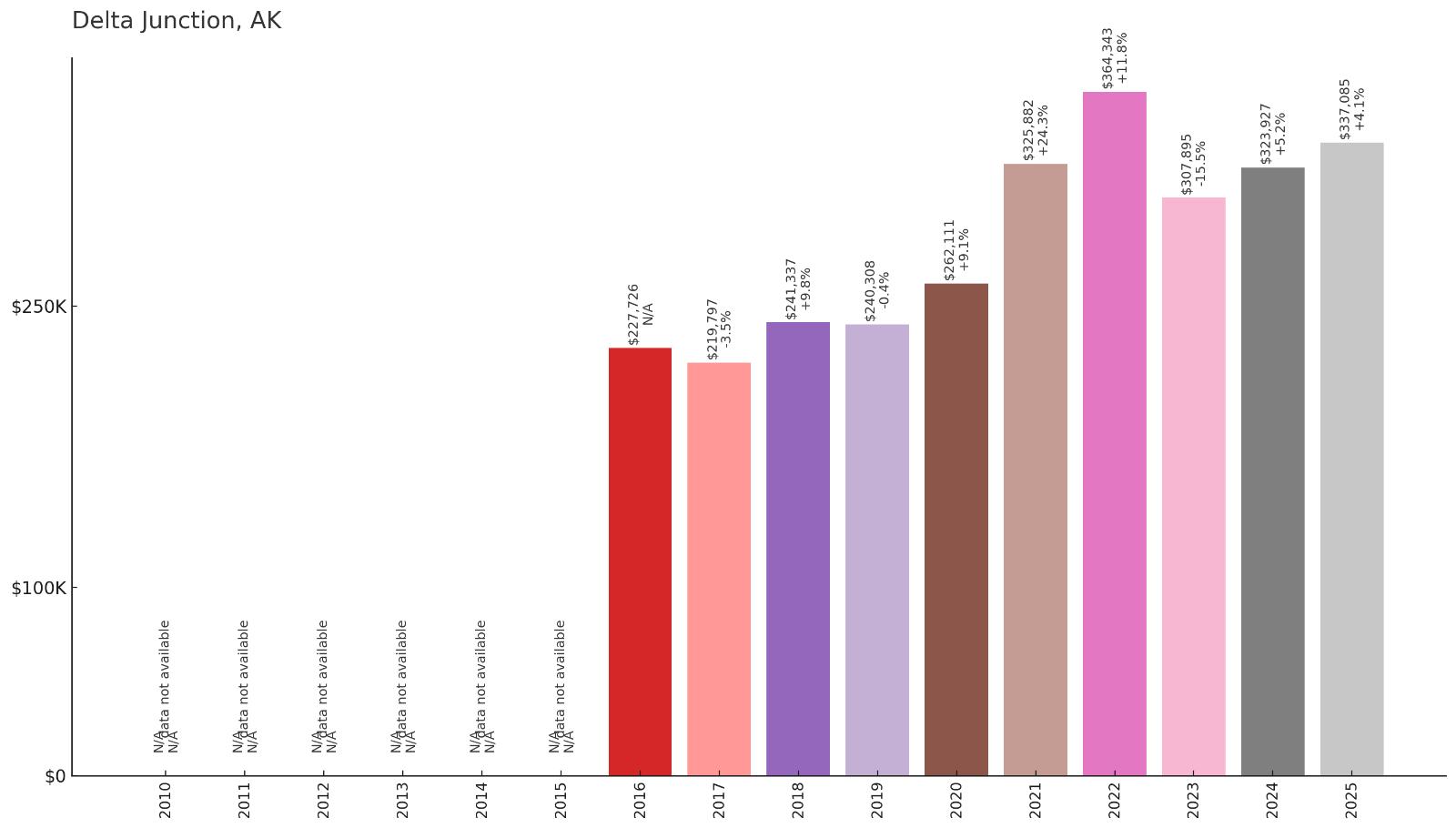
- 2010: N/A
- 2011: N/A
- 2012: N/A
- 2013: N/A
- 2014: N/A
- 2015: N/A
- 2016: $227,726
- 2017: $219,797
- 2018: $241,337
- 2019: $240,308
- 2020: $262,111
- 2021: $325,882
- 2022: $364,343
- 2023: $307,895
- 2024: $323,927
- 2025: $337,085
Delta Junction has shown strong but volatile growth since data collection began in 2016. After an initial dip in 2017, values have climbed significantly, particularly during the pandemic period when prices jumped substantially. Despite some cooling from 2022 peaks, current values represent solid appreciation from the original baseline.
Why Delta Junction?

Why Are People Willing to Pay So Much to Live Here? What’s Special About It?
Delta Junction attracts residents with its unique agricultural opportunities and strategic location at the end of the Alaska Highway. The community offers some of Alaska’s best farmland, with many residents pursuing agricultural operations ranging from grain farming to livestock ranching. The area’s relatively mild Interior climate and long summer days create ideal growing conditions for various crops.
Residents appreciate the small-town community atmosphere and the area’s outdoor recreation opportunities, including excellent hunting and fishing. The community serves as a gateway to interior Alaska’s wilderness areas while maintaining road access to the continental United States. Property owners enjoy larger lots and the potential for self-sufficient living with agriculture, gardens, and livestock.
How Delta Junction Rose to Prominence
Delta Junction developed as a supply stop during construction of the Alaska Highway in the 1940s, when the military needed staging areas for the massive road-building project. The community’s location at the junction of the Alaska and Richardson Highways made it strategically important for both military operations and civilian transportation.
The area’s agricultural potential was recognized early, and government programs encouraged farming development in the region. Large-scale agricultural projects, including barley farming for both local use and export, helped establish the community’s agricultural economy. The combination of highway access and farming opportunities attracted settlers seeking rural Alaska living with agricultural possibilities.
3 Interesting Tidbits
1. Alaska Highway End – Delta Junction is officially designated as the end of the Alaska Highway, marked by a monument commemorating the 1,387-mile road from Dawson Creek, British Columbia.
2. Barley Capital – The area produces significant quantities of barley, much of which is exported to Pacific markets for brewing and livestock feed.
3. Bison Herd – The nearby Delta Bison Range supports Alaska’s only free-roaming bison herd, descendants of animals transplanted from Montana in the 1920s.
18. Soldotna – 58% Home Price Increase Since 2010

- 2010: $221,255
- 2011: $222,119
- 2012: $226,432
- 2013: $229,568
- 2014: $233,840
- 2015: $247,422
- 2016: $258,367
- 2017: $259,424
- 2018: $263,352
- 2019: $281,288
- 2020: $287,205
- 2021: $318,395
- 2022: $351,611
- 2023: $336,309
- 2024: $342,861
- 2025: $349,686
Soldotna has shown steady appreciation since 2010, with values climbing consistently from $221,255 to $349,686 over 15 years. The community demonstrated remarkable stability through most of the 2010s before accelerating during recent years. Strong growth during 2020-2022 has been followed by some moderation, but values continue to reach new highs.
Why Soldotna?

Why Are People Willing to Pay So Much to Live Here? What’s Special About It?
Soldotna attracts residents as the commercial and government center of the Kenai Peninsula, offering urban amenities while maintaining access to world-class outdoor recreation. The city serves as the regional hub for shopping, healthcare, education, and government services while providing easy access to the legendary Kenai River fishery. Residents enjoy the benefits of a small city with the outdoor lifestyle that defines Alaska living.
The community offers well-developed infrastructure, quality schools, and diverse employment opportunities in government, healthcare, retail, and tourism sectors. Property owners appreciate the area’s central location providing access to multiple recreational areas, from Cook Inlet beaches to mountain hiking trails. The city’s services and amenities rival those of much larger communities while maintaining the friendly, accessible character of small-town Alaska.
How Soldotna Rose to Prominence
Soldotna was established in 1947 as a planned community when the federal government opened homestead lands in the area. The town was designed as a service center for the growing Kenai Peninsula population, with its central location making it ideal for regional government and commercial activities. The completion of the Sterling Highway connected Soldotna to other peninsula communities and Anchorage.
The city’s growth accelerated with oil discoveries in Cook Inlet during the 1950s and 1960s, bringing economic development and population growth. Tourism related to the world-famous Kenai River salmon fishing established Soldotna as a premier destination for sport fishing. The combination of oil revenues, government services, and tourism created a diverse economic base that supported steady community growth.
3 Interesting Tidbits
1. Kenai Peninsula Hub – Soldotna serves as the borough seat and regional center for most Kenai Peninsula communities, housing government offices and regional services.
2. Fishing Capital – The Kenai River running through Soldotna is world-famous for king salmon fishing, with the city hosting major fishing tournaments and festivals.
3. Progress Days – The annual Soldotna Progress Days festival celebrates the community’s planned development and features parades, games, and community activities.
17. Valdez – 1% Home Price Increase Since 2022
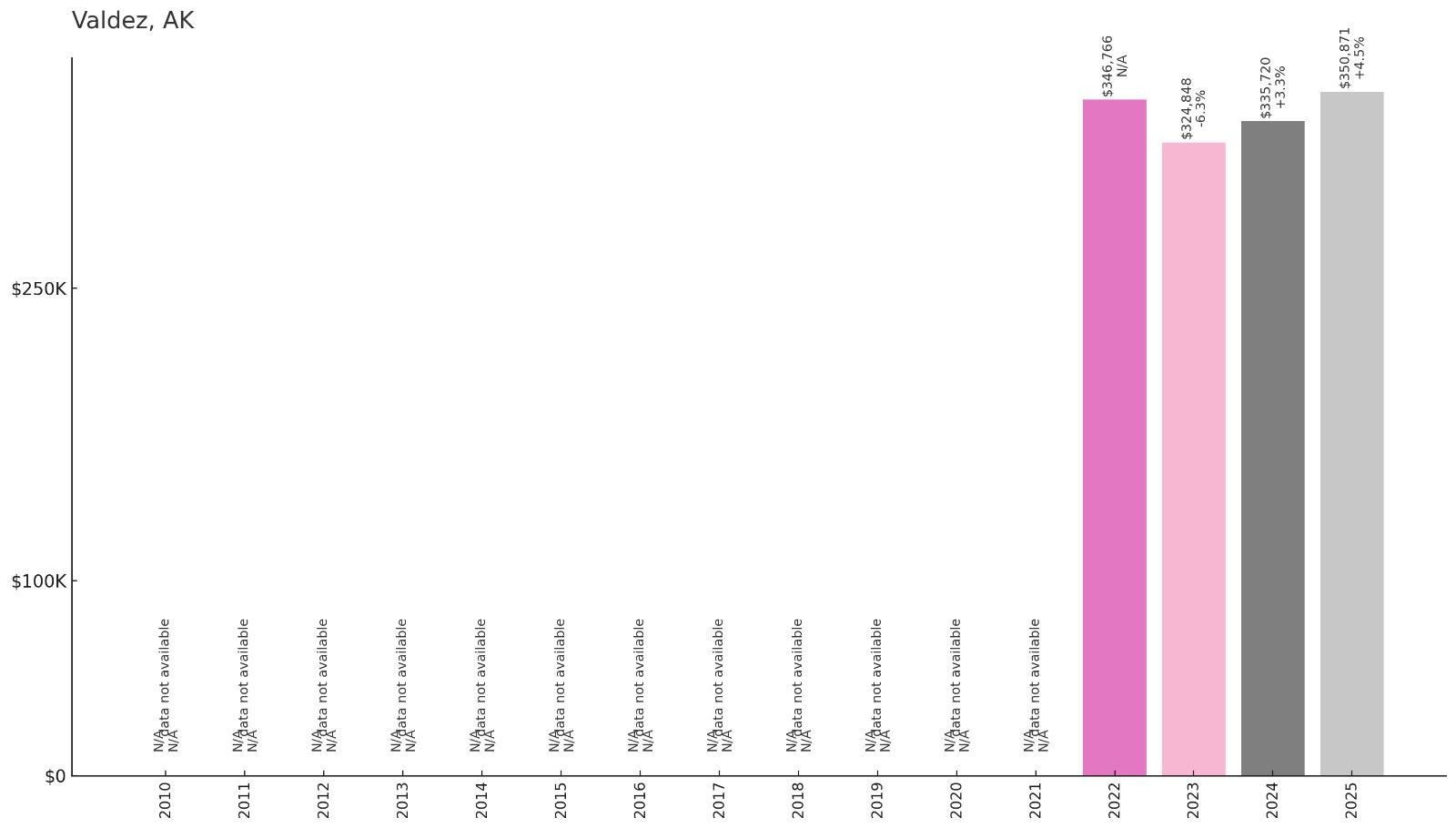
- 2010: N/A
- 2011: N/A
- 2012: N/A
- 2013: N/A
- 2014: N/A
- 2015: N/A
- 2016: N/A
- 2017: N/A
- 2018: N/A
- 2019: N/A
- 2020: N/A
- 2021: N/A
- 2022: $346,766
- 2023: $324,848
- 2024: $335,720
- 2025: $350,871
Valdez has limited data starting from 2022, showing minimal overall appreciation despite some volatility. Values dipped in 2023 before recovering in 2024 and reaching new highs in 2025. The current value of $350,871 represents modest but positive growth from the 2022 baseline of $346,766.
Why Valdez?

Why Are People Willing to Pay So Much to Live Here? What’s Special About It?
Valdez attracts residents with its dramatic mountain and marine setting in Prince William Sound, offering spectacular scenery and outdoor recreation opportunities. The community provides excellent fishing, both marine and freshwater, along with hunting and hiking in pristine wilderness areas. Residents appreciate the small-town atmosphere where everyone knows their neighbors and community connections run deep.
The city offers stable employment opportunities related to the Trans-Alaska Pipeline terminus and marine transportation, providing good wages and benefits. Property owners enjoy waterfront access and mountain views while maintaining essential services including healthcare, schools, and transportation connections. The area’s snowfall and winter recreation opportunities attract those seeking an active outdoor lifestyle year-round.
How Valdez Rose to Prominence
Valdez was founded in 1898 as a gateway to interior Alaska goldfields, when prospectors used the challenging Valdez Glacier route to reach the Klondike. The town served as a supply point and transportation hub, though the glacier route proved difficult and dangerous compared to other routes to the goldfields. Early development focused on serving prospectors and providing supplies for interior Alaska.
The community’s modern prominence came with selection as the terminus for the Trans-Alaska Pipeline in the 1970s. This decision brought massive construction activity, permanent employment, and significant tax revenue from oil operations. The 1989 Exxon Valdez oil spill brought international attention to the community and highlighted its role in Alaska’s oil industry, leading to improved environmental protections and spill response capabilities.
3 Interesting Tidbits
1. Pipeline Terminus – Valdez is the southern terminus of the Trans-Alaska Pipeline, where North Slope crude oil is loaded onto tankers for shipment to global markets.
2. Snow Capital – The area receives some of Alaska’s heaviest snowfall, with annual totals often exceeding 300 inches, making it a winter recreation paradise.
3. Ice-Free Port – Despite its northern location, Valdez maintains an ice-free deep-water port year-round, making it crucial for Alaska’s marine transportation needs.
16. Petersburg – 16% Home Price Increase Since 2017
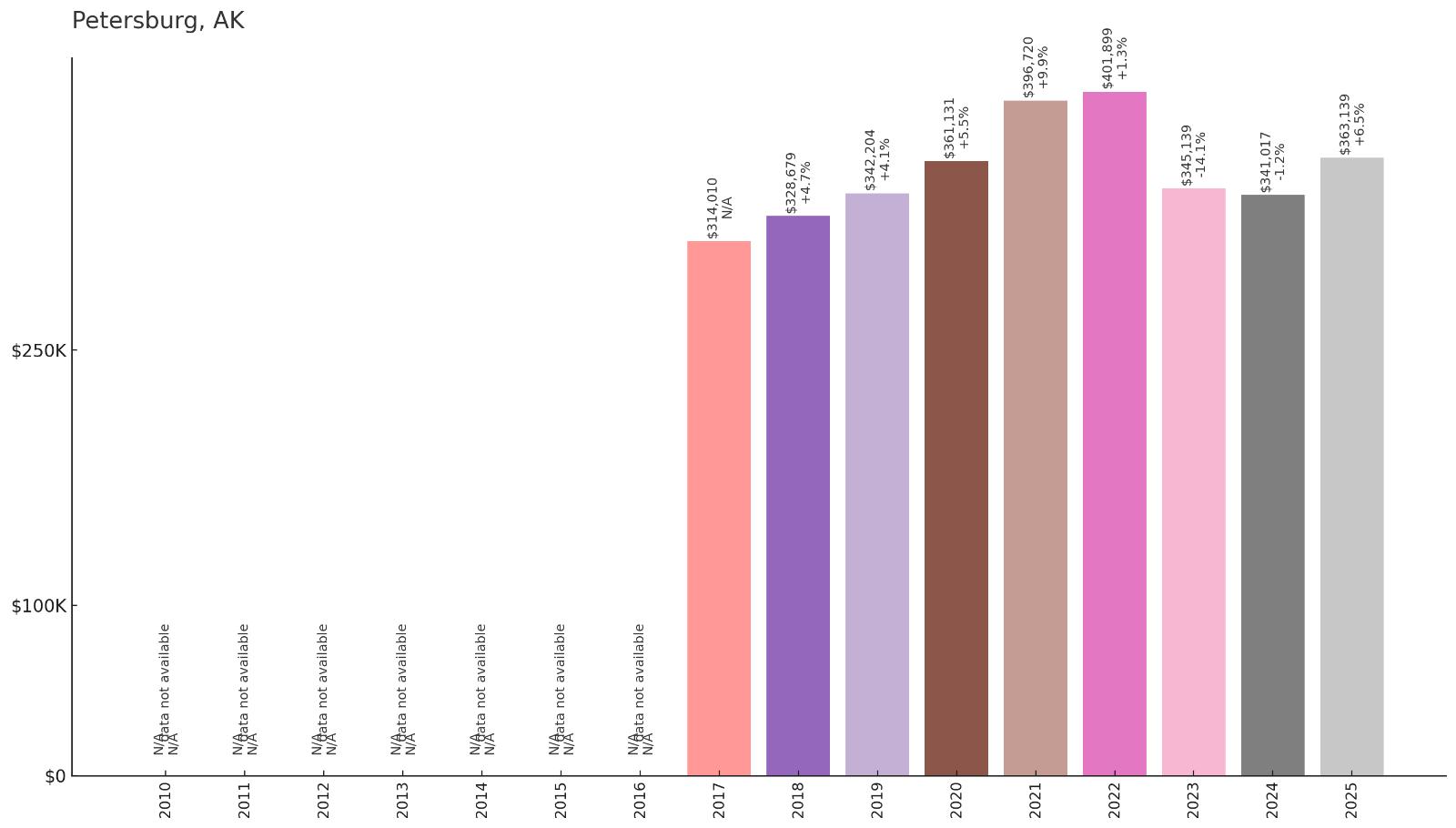
- 2010: N/A
- 2011: N/A
- 2012: N/A
- 2013: N/A
- 2014: N/A
- 2015: N/A
- 2016: N/A
- 2017: $314,010
- 2018: $328,679
- 2019: $342,204
- 2020: $361,131
- 2021: $396,720
- 2022: $401,899
- 2023: $345,139
- 2024: $341,017
- 2025: $363,139
Petersburg has shown moderate but volatile growth since data collection began in 2017. Values climbed steadily through 2022, reaching over $400,000, before experiencing significant cooling in 2023-2024. The 2025 rebound to $363,139 represents positive momentum from recent lows while remaining above the original baseline.
Why Petersburg?

Why Are People Willing to Pay So Much to Live Here? What’s Special About It?
Petersburg attracts residents with its authentic Alaska fishing community atmosphere and stunning location on Mitkof Island where Frederick Sound meets Wrangell Narrows. The community offers exceptional access to some of Alaska’s most productive fishing grounds for both commercial and sport fishing. Residents appreciate the Norwegian heritage that gives the town its “Little Norway” character and strong cultural identity.
The town provides a genuine small-town experience where community connections are strong and the pace of life remains unhurried. Property owners enjoy waterfront access and views while maintaining essential services including schools, healthcare, and regular ferry service. The area’s marine environment offers excellent opportunities for boating, fishing, and wildlife viewing in pristine Southeast Alaska waters.
How Petersburg Rose to Prominence
Petersburg was founded in 1897 by Norwegian fisherman Peter Buschmann, who recognized the area’s potential for salmon cannery operations. The community grew around fishing and cannery work, with many Norwegian and Scandinavian immigrants establishing the cultural character that persists today. The town’s location provided excellent access to salmon runs and protected waters for fishing operations.
The community’s prominence in Alaska’s fishing industry grew throughout the 20th century, with multiple canneries and a large fishing fleet based in the harbor. Petersburg became known for high-quality seafood processing and developed strong markets for salmon, halibut, and crab. The combination of commercial fishing, processing, and related services created a stable economic base that supported steady community growth.
3 Interesting Tidbits
1. Little Norway Festival – Petersburg celebrates its Scandinavian heritage with an annual Little Norway Festival featuring traditional foods, dancing, and cultural displays.
2. Shrimp Capital – The community is famous for its pink shrimp fishery, with Petersburg shrimp considered among the world’s finest and most sustainable.
3. Sons of Norway Hall – The town maintains one of Alaska’s most active Sons of Norway halls, preserving Norwegian traditions and community activities.
15. Seward – 91% Home Price Increase Since 2010
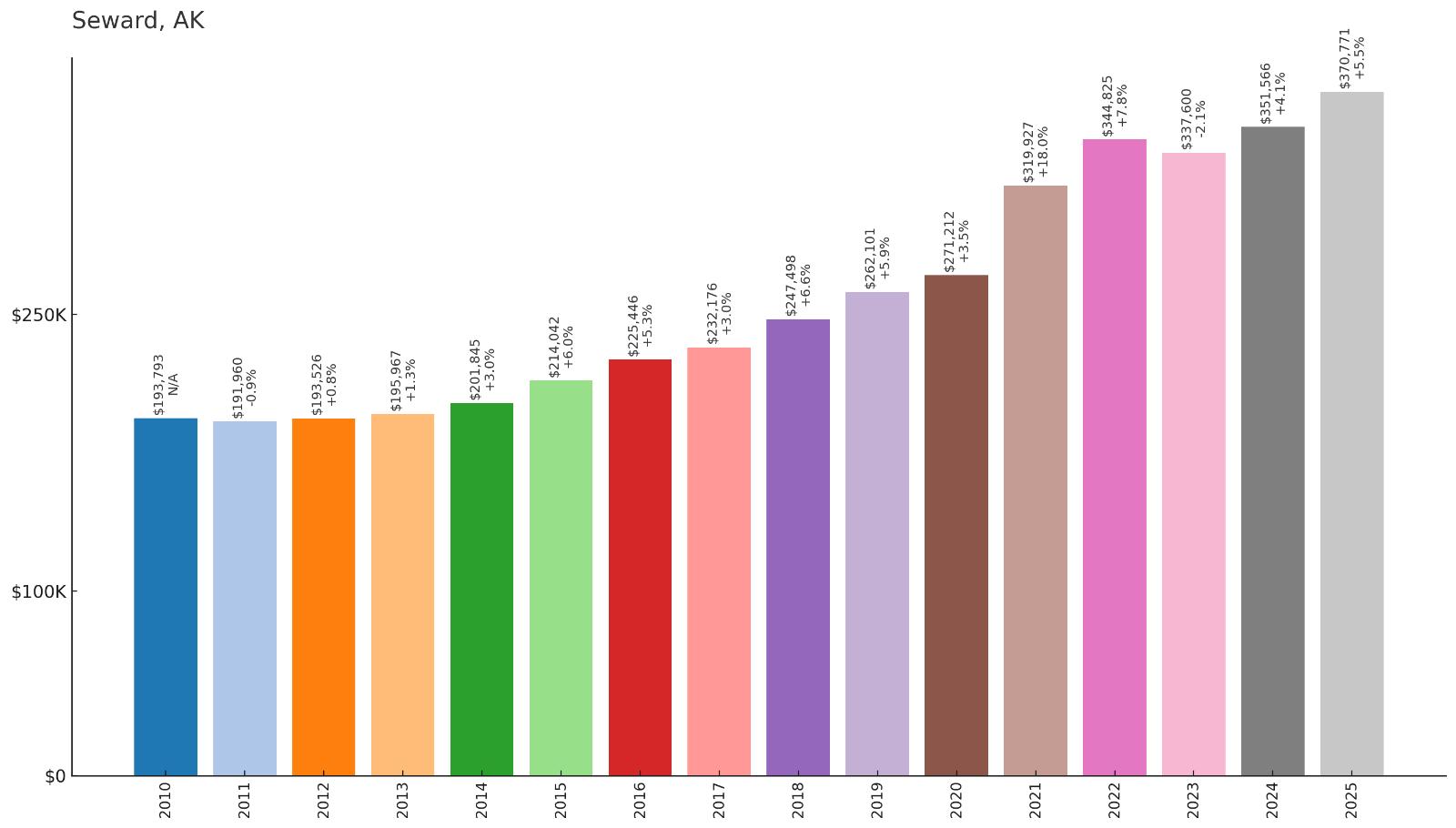
- 2010: $193,793
- 2011: $191,960
- 2012: $193,526
- 2013: $195,967
- 2014: $201,845
- 2015: $214,042
- 2016: $225,446
- 2017: $232,176
- 2018: $247,498
- 2019: $262,101
- 2020: $271,212
- 2021: $319,927
- 2022: $344,825
- 2023: $337,600
- 2024: $351,566
- 2025: $370,771
Seward has achieved impressive growth since 2010, nearly doubling in value from $193,793 to $370,771. The community showed steady but moderate appreciation through most of the 2010s before accelerating significantly during 2019-2022. Despite some cooling from peak values, the trend remains strongly upward with 2025 reaching new highs.
Why Seward?

Why Are People Willing to Pay So Much to Live Here? What’s Special About It?
Seward attracts residents with its spectacular location at the head of Resurrection Bay, surrounded by mountains and glaciers that create one of Alaska’s most scenic settings. The community serves as the gateway to Kenai Fjords National Park, offering world-class outdoor recreation including fishing, hiking, kayaking, and wildlife viewing. Residents enjoy a thriving tourism economy that supports local businesses and cultural events while maintaining authentic Alaska character.
The city offers excellent deep-water port facilities that support both commercial fishing and cruise ship tourism, creating diverse employment opportunities. Property owners appreciate waterfront access and mountain views while enjoying well-developed infrastructure and services. The community’s central role in Alaska’s tourism industry brings cultural events, restaurants, and amenities that enhance quality of life.
How Seward Rose to Prominence
Seward was founded in 1903 as the ocean terminus of the Alaska Railroad, named after Secretary of State William Seward who negotiated the Alaska Purchase. The town’s deep-water port and railroad connection made it crucial for Alaska’s development, serving as the primary gateway for people and supplies heading to interior Alaska. The community grew around railroad operations and port activities.
The devastating 1964 Good Friday earthquake destroyed much of Seward’s waterfront and required extensive rebuilding, which modernized the community’s infrastructure. The completion of the Seward Highway connected the city to Anchorage by road, reducing dependence on railroad transportation. Tourism development, particularly related to Kenai Fjords National Park and cruise ship visits, transformed Seward into one of Alaska’s premier visitor destinations.
3 Interesting Tidbits
1. Mount Marathon Race – Seward hosts the famous Mount Marathon Race each July 4th, a grueling uphill run that’s been held annually since 1915.
2. SeaLife Center – The Alaska SeaLife Center, a major research and visitor attraction, rehabilitates marine wildlife and conducts important ocean research.
3. Iditarod Connection – Seward served as the original starting point for the Iditarod Trail, the historic route to interior Alaska goldfields that inspired the famous sled dog race.
14. Meadow Lakes – 54% Home Price Increase Since 2016
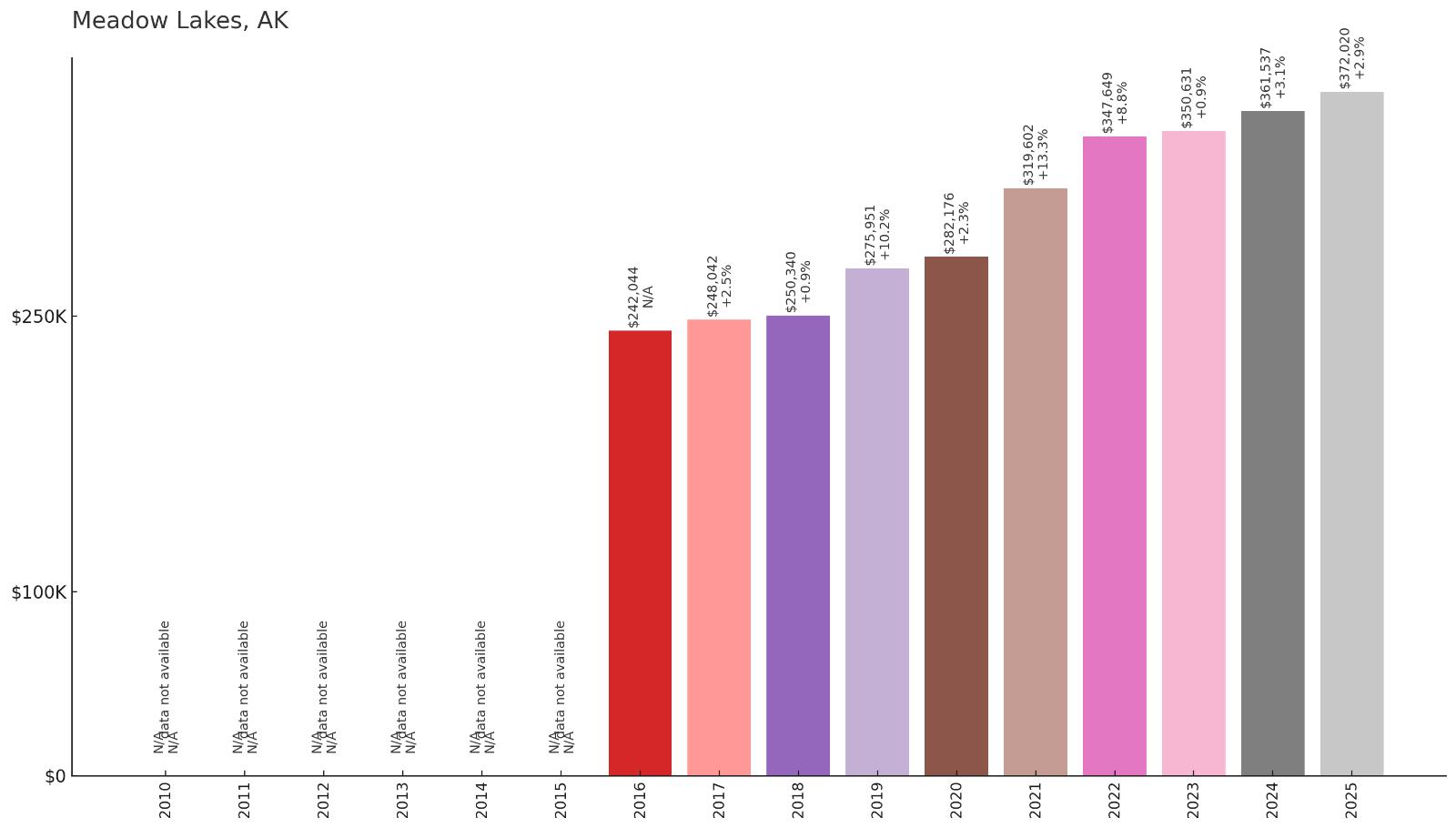
- 2010: N/A
- 2011: N/A
- 2012: N/A
- 2013: N/A
- 2014: N/A
- 2015: N/A
- 2016: $242,044
- 2017: $248,042
- 2018: $250,340
- 2019: $275,951
- 2020: $282,176
- 2021: $319,602
- 2022: $347,649
- 2023: $350,631
- 2024: $361,537
- 2025: $372,020
Meadow Lakes has shown consistent growth since data collection began in 2016, with values climbing from $242,044 to $372,020. The community demonstrated steady appreciation through the late 2010s before accelerating during the pandemic period. Recent years show continued strength with values reaching new highs each year through 2025.
Why Meadow Lakes?

Why Are People Willing to Pay So Much to Live Here? What’s Special About It?
Meadow Lakes attracts residents seeking suburban living with easy access to both Anchorage and Wasilla employment while maintaining a more rural residential character. The community offers larger lots, newer subdivisions, and custom homes that appeal to families wanting space and privacy. Residents appreciate excellent schools, recreational facilities, and the area’s family-friendly atmosphere with strong community connections.
The area provides a perfect balance of suburban conveniences and outdoor recreation opportunities, with easy access to hiking, fishing, and hunting areas. Property owners enjoy the community’s well-planned development, quality infrastructure, and proximity to shopping and services in nearby Wasilla. The location offers reasonable commuting access to Anchorage while maintaining the benefits of small-town living.
How Meadow Lakes Rose to Prominence
Meadow Lakes developed as part of the broader suburban expansion of the Matanuska-Susitna Valley during Alaska’s oil boom years. The area was originally agricultural land that was gradually converted to residential development as families sought alternatives to Anchorage city living. Planned subdivisions attracted residents wanting newer homes with larger lots and modern amenities.
The community’s growth accelerated as transportation improvements made commuting to Anchorage more feasible while maintaining lower property costs than city living. The area’s development emphasized quality residential neighborhoods with good schools and recreational amenities. Careful planning and zoning helped create a desirable residential community that attracted families and maintained property values.
3 Interesting Tidbits
1. Lake Access – The community is named for the numerous small lakes throughout the area, many providing fishing and recreational opportunities for residents.
2. Planned Community – Meadow Lakes represents one of Alaska’s most successful examples of planned suburban development, with coordinated infrastructure and amenities.
3. Youth Sports – The community is known for its excellent youth sports programs and facilities, attracting families who prioritize children’s activities and education.
13. Cordova – 0% Home Price Increase Since 2022

- 2010: N/A
- 2011: N/A
- 2012: N/A
- 2013: N/A
- 2014: N/A
- 2015: N/A
- 2016: N/A
- 2017: N/A
- 2018: N/A
- 2019: N/A
- 2020: N/A
- 2021: N/A
- 2022: $390,019
- 2023: $335,950
- 2024: $343,210
- 2025: $391,026
Cordova has limited data starting from 2022, showing volatile but ultimately flat growth over the short period tracked. Values dropped significantly in 2023 before partially recovering in 2024 and surging in 2025. The current value essentially matches the 2022 baseline, indicating underlying market stability despite recent fluctuations.
Why Cordova?

Why Are People Willing to Pay So Much to Live Here? What’s Special About It?
Cordova attracts residents with its authentic Alaska fishing community atmosphere and spectacular location in Prince William Sound. The town offers exceptional commercial and sport fishing opportunities, with some of Alaska’s most productive salmon runs and marine fisheries. Residents appreciate the tight-knit community where traditional fishing culture remains strong and neighbors support each other through seasonal economic cycles.
The community provides unique access to pristine wilderness areas including the Copper River Delta, one of North America’s most important bird migration areas. Property owners enjoy waterfront access and mountain views while maintaining essential services despite the town’s remote location accessible only by air or sea. The area’s natural beauty and wildlife viewing opportunities attract those seeking authentic Alaska living.
How Cordova Rose to Prominence
Cordova was established in 1908 as the coastal terminus of the Copper River and Northwestern Railway, built to transport copper ore from interior mines to ocean shipping. The town grew rapidly during the early 1900s as a major shipping point for copper from the Kennecott mines. The community’s deep-water harbor and strategic location made it crucial for Alaska’s early mineral development.
After copper mining declined in the 1930s, Cordova transformed into a fishing community, with salmon and later herring supporting the local economy. The town became known for high-quality seafood processing and developed strong markets for its marine products. Despite challenges including the 1989 Exxon Valdez oil spill that damaged local fisheries, Cordova has maintained its identity as an authentic Alaska fishing community.
3 Interesting Tidbits
1. Copper River Salmon – Cordova is the primary port for world-famous Copper River salmon, prized by chefs and seafood lovers for their exceptional flavor and quality.
2. Ice Worm Festival – The town celebrates winter with the quirky Ice Worm Festival, complete with a parade featuring a 150-foot-long ice worm puppet.
3. Million Dollar Bridge – The historic Copper River Bridge, nicknamed the “Million Dollar Bridge,” still stands as a testament to early 20th-century engineering in Alaska.
12. Ketchikan – 74% Home Price Increase Since 2010
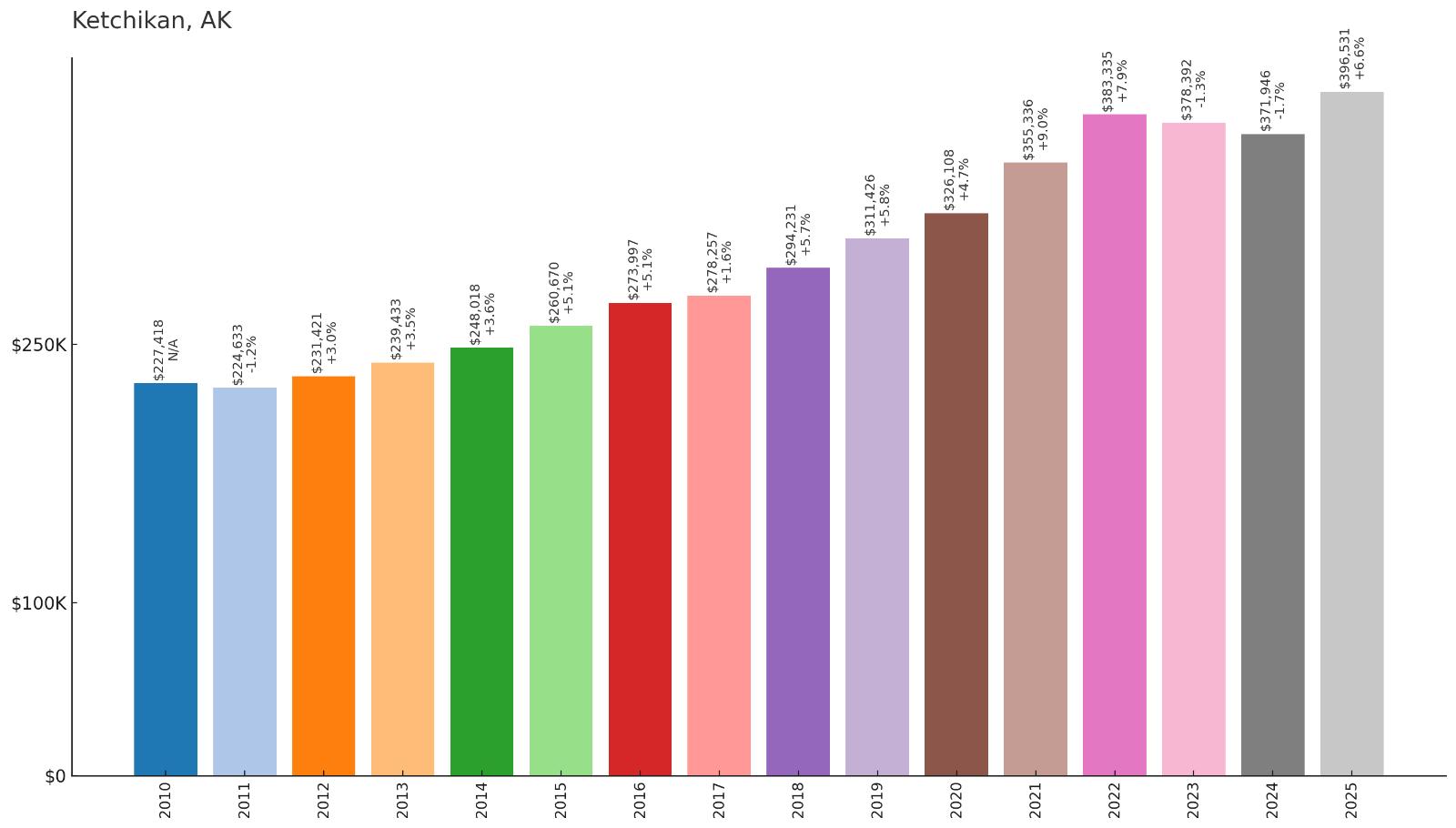
- 2010: $227,418
- 2011: $224,633
- 2012: $231,421
- 2013: $239,433
- 2014: $248,018
- 2015: $260,670
- 2016: $273,997
- 2017: $278,257
- 2018: $294,231
- 2019: $311,426
- 2020: $326,108
- 2021: $355,336
- 2022: $383,335
- 2023: $378,392
- 2024: $371,946
- 2025: $396,531
Ketchikan has demonstrated strong appreciation since 2010, with values climbing from $227,418 to $396,531 over 15 years. The community showed consistent growth throughout the period, with particularly strong performance during 2018-2022. Despite some volatility in recent years, the 2025 surge to nearly $400,000 represents continued market strength.
Why Ketchikan?

Why Are People Willing to Pay So Much to Live Here? What’s Special About It?
Ketchikan attracts residents as Southeast Alaska’s gateway city, offering urban amenities while maintaining access to pristine wilderness and exceptional fishing opportunities. The community serves as a major cruise ship destination and regional hub, providing diverse employment in tourism, government, healthcare, and transportation sectors. Residents enjoy the city’s rich Native culture, particularly the world’s largest collection of totem poles and active Tlingit, Haida, and Tsimshian communities.
The city offers well-developed infrastructure including quality schools, healthcare facilities, and cultural amenities that rival much larger communities. Property owners appreciate waterfront access and temperate rainforest settings while maintaining urban conveniences. The area’s year-round accessibility by air and sea, combined with its role as a transportation hub, provides economic stability and growth opportunities.
How Ketchikan Rose to Prominence
Ketchikan was founded in the 1880s as a salmon saltery and cannery town, taking advantage of abundant salmon runs in local creeks. The community’s name comes from a Tlingit word meaning “creek of the thundering wings of an eagle.” The town grew rapidly during the early 1900s as multiple canneries processed millions of salmon annually, making it one of the world’s largest salmon-canning centers.
The community diversified beyond fishing with timber operations and later became a major stop for Alaska’s growing tourism industry. Ketchikan’s collection of totem poles and Native cultural sites attracted visitors, while its strategic location made it the first Alaska port of call for cruise ships. The combination of traditional industries, government services, and tourism created a stable, diverse economy supporting steady growth.
3 Interesting Tidbits
1. Totem Capital – Ketchikan houses the world’s largest collection of standing totem poles, with dozens of authentic poles displayed throughout the city and nearby villages.
2. Creek Street – The historic Creek Street district was once Ketchikan’s red-light district, built on stilts over the salmon-spawning creek that runs through downtown.
3. Rainiest City – Ketchikan receives over 150 inches of rainfall annually, earning it the nickname “Alaska’s First City” for both its southern location and precipitation levels.
11. Homer – 73% Home Price Increase Since 2010
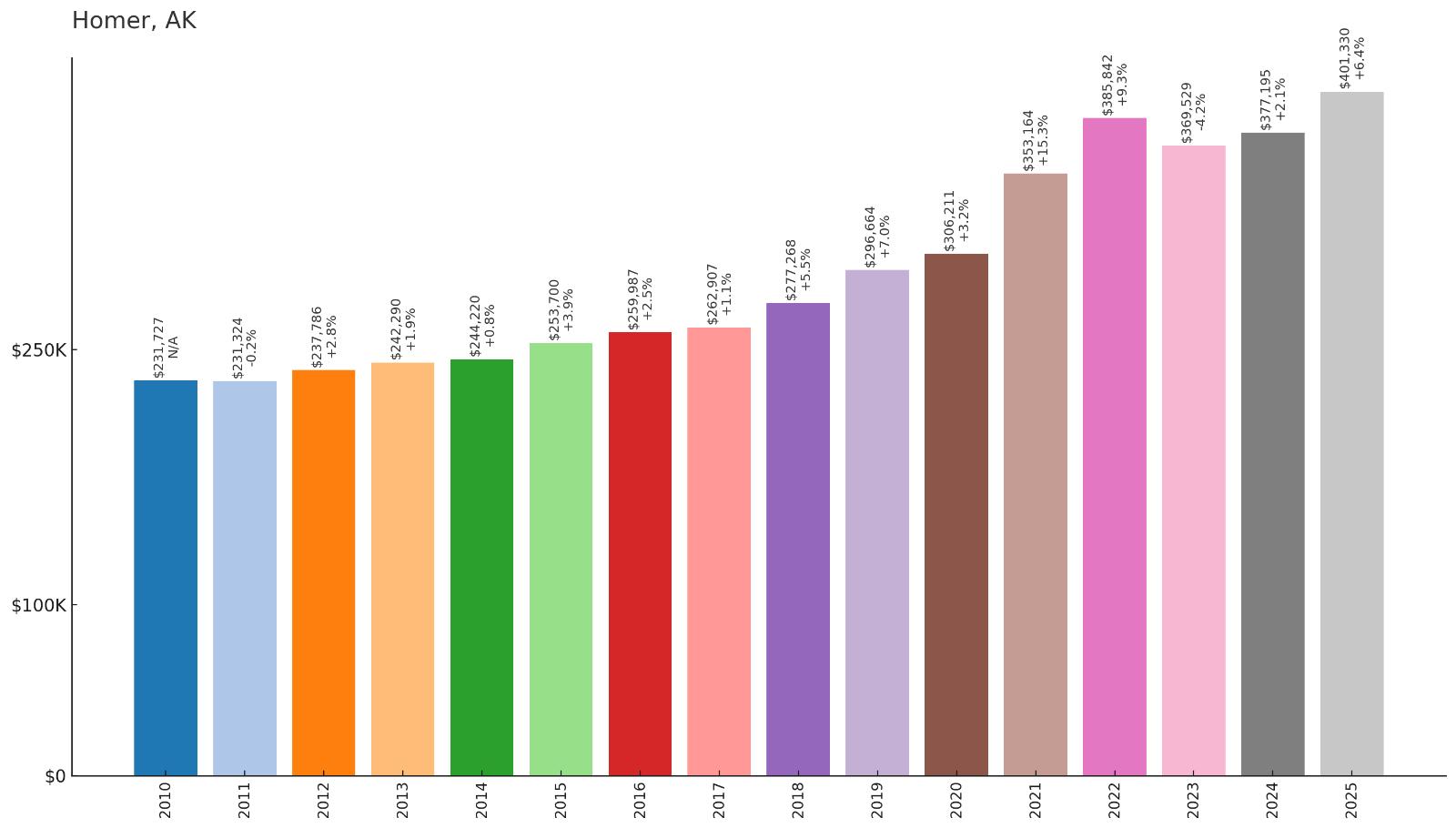
- 2010: $231,727
- 2011: $231,324
- 2012: $237,786
- 2013: $242,290
- 2014: $244,220
- 2015: $253,700
- 2016: $259,987
- 2017: $262,907
- 2018: $277,268
- 2019: $296,664
- 2020: $306,211
- 2021: $353,164
- 2022: $385,842
- 2023: $369,529
- 2024: $377,195
- 2025: $401,330
Homer has achieved impressive growth since 2010, with values climbing from $231,727 to $401,330 over 15 years. The community showed steady but moderate appreciation through most of the 2010s before accelerating significantly during 2019-2022. Despite some cooling from peak values, the strong 2025 performance demonstrates continued market appeal.
Why Homer?

Why Are People Willing to Pay So Much to Live Here? What’s Special About It?
Homer attracts residents with its stunning location on Kachemak Bay, featuring spectacular mountain and ocean views that have earned it the nickname “Halibut Fishing Capital of the World.” The community offers exceptional fishing opportunities, both saltwater and freshwater, along with world-class hiking, kayaking, and wildlife viewing. Residents appreciate the thriving arts community that brings galleries, theaters, and cultural events to this scenic coastal town.
The city provides a unique combination of small-town Alaska living with sophisticated cultural amenities and outdoor recreation opportunities. Property owners enjoy waterfront access and dramatic landscapes while maintaining quality schools, healthcare, and transportation connections. The area’s tourism economy supports diverse local businesses and restaurants while preserving authentic Alaska character.
How Homer Rose to Prominence
Homer was established in 1896 when Homer Pennock arrived to develop coal deposits in the area. Early settlement focused on coal mining and later expanded to include farming operations that took advantage of the area’s relatively mild climate and fertile soils. The community’s natural harbor on Kachemak Bay made it an important fishing and transportation center.
The town’s transformation into a major fishing and tourism destination began with the development of sport fishing for halibut and salmon. The famous Homer Spit, a 4.5-mile sand bar extending into Kachemak Bay, became a focal point for fishing charters and tourism activities. The combination of natural beauty, fishing opportunities, and arts community attracted visitors and new residents, establishing Homer as one of Alaska’s premier small cities.
3 Interesting Tidbits
1. The Spit – Homer Spit is one of the longest road-accessible spits in the world, extending 4.5 miles into Kachemak Bay and serving as the heart of the fishing industry.
2. Arts Community – Homer has one of Alaska’s most vibrant arts communities, with dozens of galleries, studios, and cultural events including the annual Concert on the Lawn series.
3. Cosmic Hamlet – Homer calls itself the “Cosmic Hamlet by the Sea,” reflecting both its small-town character and its reputation as a gathering place for artists, writers, and free spirits.
10. Anchorage – 46% Home Price Increase Since 2010

- 2010: $275,086
- 2011: $267,805
- 2012: $278,545
- 2013: $292,252
- 2014: $297,128
- 2015: $308,978
- 2016: $314,503
- 2017: $312,277
- 2018: $314,955
- 2019: $337,438
- 2020: $339,258
- 2021: $350,536
- 2022: $373,817
- 2023: $385,917
- 2024: $389,038
- 2025: $402,156
Anchorage has shown steady appreciation since 2010, with values climbing from $275,086 to $402,156 over 15 years. Alaska’s largest city demonstrated remarkable stability through most periods, with consistent but measured growth that accelerated somewhat in recent years. The steady progression reflects the mature urban market’s resilience and continued demand.
Why Anchorage?

Why Are People Willing to Pay So Much to Live Here? What’s Special About It?
Anchorage attracts residents as Alaska’s economic and cultural center, offering urban amenities and employment opportunities while maintaining easy access to world-class outdoor recreation. The city provides excellent schools, healthcare, shopping, and cultural facilities that rival those of much larger metropolitan areas. Residents enjoy diverse job markets in government, military, healthcare, tourism, and private sector businesses while living surrounded by mountains, forests, and wildlife.
The metropolitan area offers suburban neighborhoods with mountain views, urban downtown living, and rural residential options all within easy commuting distance. Property owners appreciate the city’s well-developed infrastructure, quality services, and year-round accessibility by air, sea, and land. The combination of urban convenience and Alaska wilderness access creates a unique lifestyle that attracts residents from across the United States.
How Anchorage Rose to Prominence
Anchorage was founded in 1914 as a railroad construction camp during building of the Alaska Railroad connecting the coast to interior Alaska. The city’s location at the head of Cook Inlet provided an ideal harbor and staging area for railroad construction and supply operations. Early growth centered on railroad activities and serving as a transportation hub for south-central Alaska.
World War II transformed Anchorage from a small railroad town into a major military strategic location, with massive bases constructed to defend Alaska and support Pacific operations. Post-war military presence, oil discoveries, and Alaska statehood drove rapid population growth. The 1964 earthquake devastated the city but rebuilding efforts modernized infrastructure and established Anchorage as Alaska’s dominant metropolitan area.
3 Interesting Tidbits
1. Urban Wildlife – Anchorage is famous for urban wildlife encounters, with moose regularly seen on city streets and bears occasionally visiting residential neighborhoods.
2. Aviation Hub – Anchorage’s airport handles more cargo than almost any other airport in North America, serving as a crucial refueling stop for international flights between Asia and North America.
3. Earthquake History – The 1964 Good Friday earthquake, one of the strongest ever recorded, devastated much of Anchorage but led to improved building codes and modern urban planning.
9. Wasilla – 71% Home Price Increase Since 2010
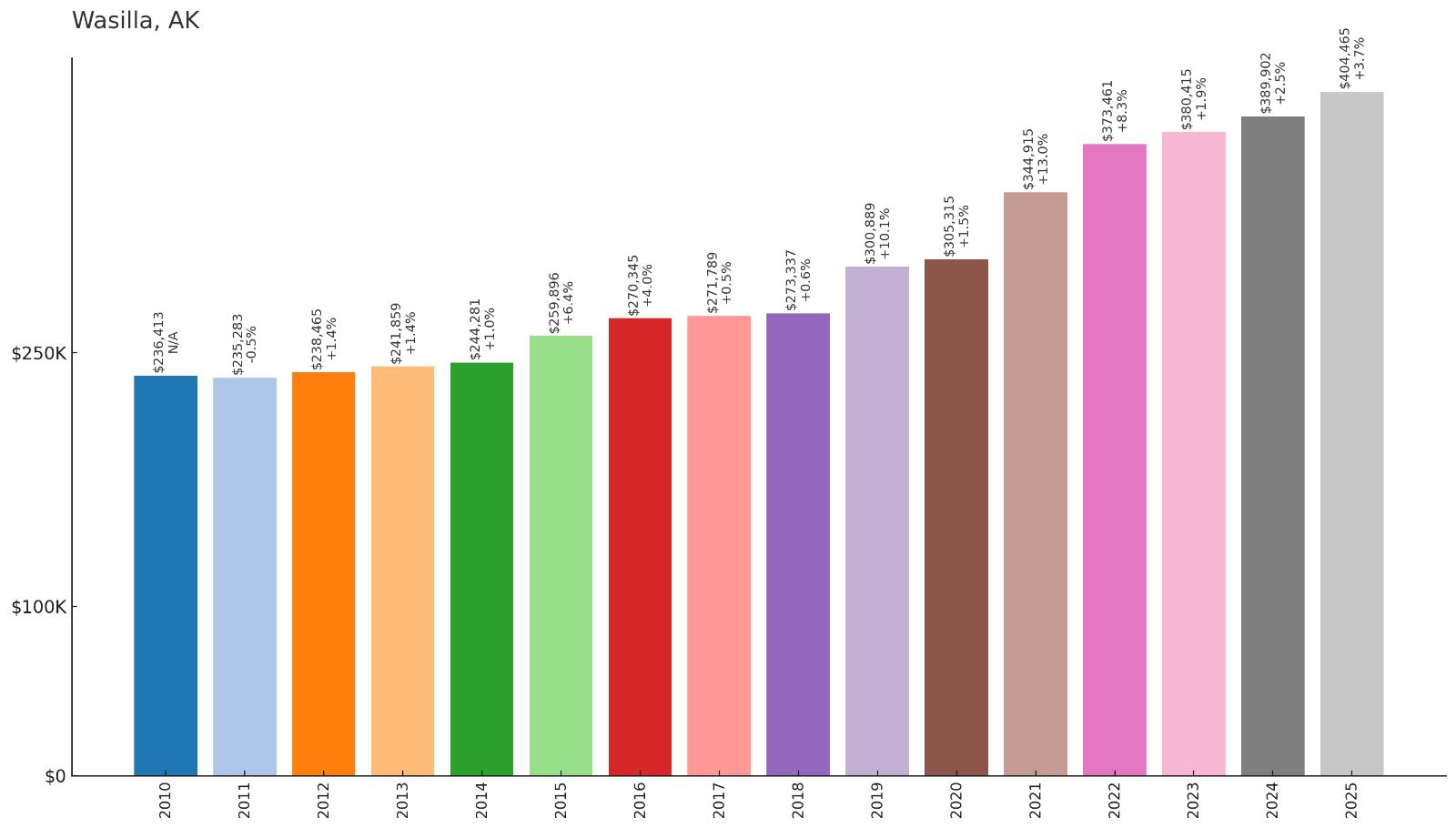
- 2010: $236,413
- 2011: $235,283
- 2012: $238,465
- 2013: $241,859
- 2014: $244,281
- 2015: $259,896
- 2016: $270,345
- 2017: $271,789
- 2018: $273,337
- 2019: $300,889
- 2020: $305,315
- 2021: $344,915
- 2022: $373,461
- 2023: $380,415
- 2024: $389,902
- 2025: $404,465
Wasilla has achieved strong growth since 2010, with values climbing from $236,413 to $404,465 over 15 years. The community showed steady but modest appreciation through most of the 2010s before accelerating significantly during 2019-2022. Recent years demonstrate continued strength with values reaching new highs annually through 2025.
Why Wasilla?

Why Are People Willing to Pay So Much to Live Here? What’s Special About It?
Wasilla attracts residents seeking suburban living with easy access to both Anchorage employment and exceptional outdoor recreation opportunities. The community offers family-friendly neighborhoods, quality schools, and shopping amenities while maintaining the Alaska lifestyle with abundant hunting, fishing, and hiking nearby. Residents appreciate larger lots, newer homes, and the area’s reputation as a center for Alaska’s recreational vehicle and outdoor sports culture.
The city serves as the commercial hub for the Matanuska-Susitna Valley, providing shopping, services, and employment opportunities for the broader region. Property owners enjoy the community’s growth and development while maintaining reasonable commuting access to Anchorage. The area’s lakes, trails, and recreational facilities support year-round outdoor activities from skiing and snowmobiling to fishing and camping.
How Wasilla Rose to Prominence
Wasilla was established in 1917 as a stop on the Alaska Railroad, named after Chief Wasilla of the local Dena’ina Athabascan people. The community served as a supply point for miners and homesteaders heading to interior areas. Early development centered on railroad operations and serving as a trading center for the agricultural Matanuska Valley.
The city’s modern growth began during Alaska’s oil boom years when families sought alternatives to expensive Anchorage housing while maintaining access to urban employment. Wasilla became the fastest-growing city in Alaska during the 1980s and 1990s as suburban development expanded throughout the valley. The community gained national attention as the hometown of Governor Sarah Palin, highlighting its role as a growing suburban center.
3 Interesting Tidbits
1. Iditarod Restart – Wasilla serves as the official restart point for the Iditarod Trail Sled Dog Race, hosting the ceremonial restart each March.
2. Valley Growth – Wasilla is the largest city in the Mat-Su Valley, Alaska’s fastest-growing region, attracting families seeking suburban living with rural character.
3. Lake Culture – The area features dozens of lakes that support year-round recreation, from ice fishing and skating in winter to boating and swimming in summer.
8. Palmer – 74% Home Price Increase Since 2010
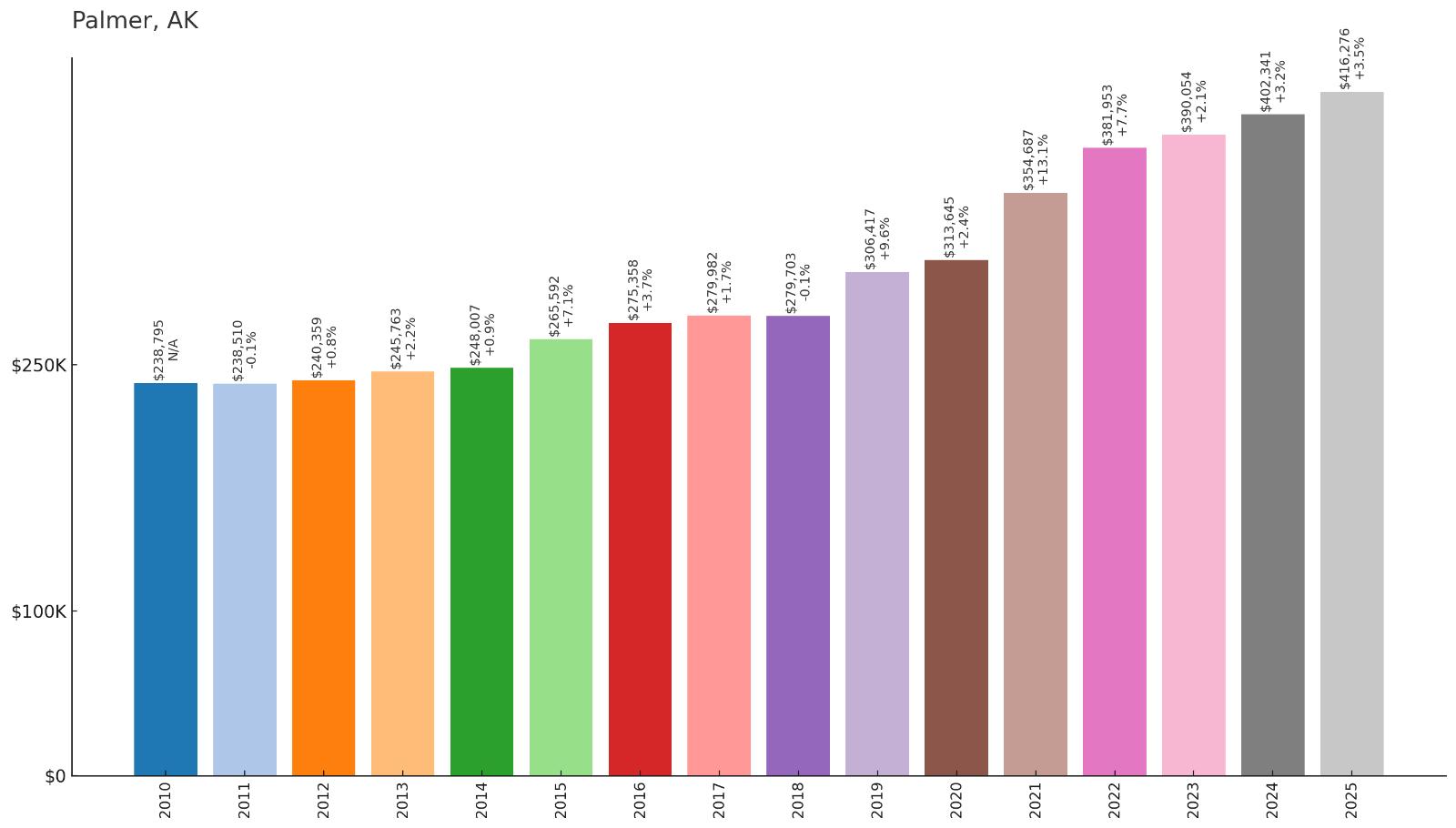
- 2010: $238,795
- 2011: $238,510
- 2012: $240,359
- 2013: $245,763
- 2014: $248,007
- 2015: $265,592
- 2016: $275,358
- 2017: $279,982
- 2018: $279,703
- 2019: $306,417
- 2020: $313,645
- 2021: $354,687
- 2022: $381,953
- 2023: $390,054
- 2024: $402,341
- 2025: $416,276
Palmer has demonstrated impressive appreciation since 2010, with values climbing from $238,795 to $416,276 over 15 years. The community showed steady growth through most of the period with notable acceleration beginning in 2019. Strong performance has continued through recent years, with values reaching new peaks annually and showing no signs of cooling.
Why Palmer?

Why Are People Willing to Pay So Much to Live Here? What’s Special About It?
Palmer attracts residents with its unique combination of Alaska’s agricultural heritage and modern suburban convenience in the heart of the fertile Matanuska Valley. The community offers family-friendly neighborhoods, excellent schools, and small-town character while providing easy access to Anchorage employment opportunities. Residents appreciate the area’s farming culture, farmers markets, and the famous Alaska State Fair held annually in Palmer.
The city provides well-developed infrastructure and services while maintaining connection to Alaska’s agricultural roots and outdoor recreation opportunities. Property owners enjoy larger lots, mountain views, and the area’s slightly warmer climate that supports gardening and farming activities. The community’s central location in the Mat-Su Valley provides access to hiking, fishing, and hunting while maintaining urban conveniences.
How Palmer Rose to Prominence
Palmer was established in 1935 as part of the federal government’s New Deal Matanuska Colony project, which brought farming families from the Midwest to establish Alaska’s agricultural industry. The town was carefully planned as the commercial center for the colony, with infrastructure designed to support farming operations and rural families. The project aimed to prove that Alaska could produce its own food and support agricultural settlement.
The community grew around its agricultural base and became the heart of Alaska’s farming industry, known particularly for producing oversized vegetables due to long summer daylight hours. The Alaska State Fair, established to showcase local agricultural products, became one of Alaska’s premier annual events. Palmer’s role as the agricultural center combined with suburban growth from nearby Anchorage established it as a major Mat-Su Valley community.
3 Interesting Tidbits
1. Colony Project – Palmer was founded as part of the 1930s Matanuska Colony, a New Deal program that relocated 202 farming families from the Midwest to establish agriculture in Alaska.
2. Giant Vegetables – The area is famous for producing record-breaking giant vegetables, including cabbages weighing over 130 pounds, thanks to nearly 24-hour summer daylight.
3. State Fair – The Alaska State Fair in Palmer is the state’s largest annual event, showcasing agriculture, entertainment, and crafts from across Alaska.
7. Kodiak – 79% Home Price Increase Since 2010

- 2010: $246,823
- 2011: $265,234
- 2012: $277,134
- 2013: $283,843
- 2014: $293,997
- 2015: $306,472
- 2016: $302,905
- 2017: $315,205
- 2018: $330,735
- 2019: $360,246
- 2020: $373,451
- 2021: $409,055
- 2022: $452,510
- 2023: $416,608
- 2024: $400,462
- 2025: $441,106
Kodiak has shown strong appreciation since 2010, with values climbing from $246,823 to $441,106 over 15 years. The community demonstrated consistent growth through most periods, with major gains during 2019-2022 when values peaked above $450,000. Despite some cooling in recent years, the 2025 rebound shows continued underlying strength in this island community.
Why Kodiak?

Why Are People Willing to Pay So Much to Live Here? What’s Special About It?
Kodiak attracts residents with its unique island setting that combines a thriving commercial fishing industry with stunning natural beauty and outdoor recreation opportunities. The community hosts Alaska’s largest Coast Guard base and serves as a major fishing port, providing stable employment in both military and civilian sectors. Residents enjoy world-class fishing, hunting, and wildlife viewing, including the famous Kodiak brown bears that inhabit the island.
The city offers well-developed infrastructure and services despite its island location, with quality schools, healthcare, and transportation connections to the mainland. Property owners appreciate the community’s authentic Alaska character and strong maritime culture while maintaining modern amenities. The island’s limited land supply and shipping logistics contribute to property values while preserving the area’s pristine environment.
How Kodiak Rose to Prominence
Kodiak has been continuously occupied for over 7,000 years by Alaska Native peoples, and was established as the first capital of Russian America in 1792. The island served as the headquarters for Russian fur trading operations and Orthodox missionary activities throughout Alaska. The community’s excellent harbor and strategic location made it crucial for maritime operations and trade.
The modern city developed around commercial fishing and seafood processing, becoming one of the nation’s largest fishing ports by volume and value. World War II brought military installations that remain important today, including major Coast Guard facilities. The combination of commercial fishing, government employment, and tourism related to the island’s natural beauty established Kodiak as a major Alaska community despite its remote island location.
3 Interesting Tidbits
1. Bear Island – Kodiak Island is home to the famous Kodiak brown bears, the largest subspecies of brown bear in the world, with some males weighing over 1,500 pounds.
2. Russian Capital – Kodiak was the first capital of Russian America from 1792 to 1808, and still maintains historic Russian Orthodox churches and cultural influences.
3. Fishing Powerhouse – The Port of Kodiak consistently ranks among America’s top fishing ports by value, processing millions of pounds of seafood annually.
6. Juneau – 61% Home Price Increase Since 2010

- 2010: $285,676
- 2011: $287,202
- 2012: N/A
- 2013: $316,705
- 2014: $323,985
- 2015: $343,302
- 2016: $350,115
- 2017: $357,849
- 2018: $367,813
- 2019: $369,510
- 2020: $371,582
- 2021: $406,174
- 2022: $438,756
- 2023: $434,162
- 2024: $444,571
- 2025: $460,423
Juneau has achieved solid appreciation since 2010, with values climbing from $285,676 to $460,423 despite missing 2012 data. Alaska’s capital city showed consistent growth throughout most periods, with particularly strong performance during 2015-2022. Recent years demonstrate continued strength with values reaching new highs and showing sustained demand.
Why Juneau?

Why Are People Willing to Pay So Much to Live Here? What’s Special About It?
Juneau attracts residents as Alaska’s capital city, providing stable government employment and urban amenities in one of America’s most scenic settings. The city offers excellent educational opportunities through the University of Alaska Southeast and quality healthcare, schools, and cultural facilities. Residents enjoy world-class outdoor recreation including hiking, fishing, whale watching, and glacier viewing, all within minutes of downtown.
The community provides unique access to both political and economic opportunities as the seat of state government, while maintaining authentic Southeast Alaska character. Property owners appreciate waterfront access, mountain views, and the city’s walkable downtown area with restaurants, shops, and cultural attractions. The area’s year-round accessibility and transportation connections support a diverse economy beyond government employment.
How Juneau Rose to Prominence
Juneau was founded in 1880 following gold discoveries in the area by prospectors Joe Juneau and Richard Harris. The community grew rapidly as a gold mining center, with large-scale operations including the famous Alaska-Juneau Mine. The town’s deep-water harbor and strategic location in Southeast Alaska made it an important transportation and supply center.
Juneau became Alaska’s territorial capital in 1906, replacing Sitka, due to its growing importance and accessibility. The community’s economy diversified from mining to government, tourism, and fishing as territorial and later state government operations expanded. Despite several attempts to move the capital closer to Alaska’s population center, Juneau has retained its status and developed into a major Southeast Alaska city.
3 Interesting Tidbits
1. Glacier Access – Juneau is one of the few capital cities in the world with glaciers accessible by road, including the famous Mendenhall Glacier just 12 miles from downtown.
2. No Roads Out – Despite being Alaska’s capital, Juneau is not connected to any road system and can only be reached by boat or plane.
3. Whale Highway – The waters around Juneau are part of a major humpback whale feeding area, with whale watching being a major summer tourist attraction.
5. Eagle River – 31% Home Price Increase Since 2016
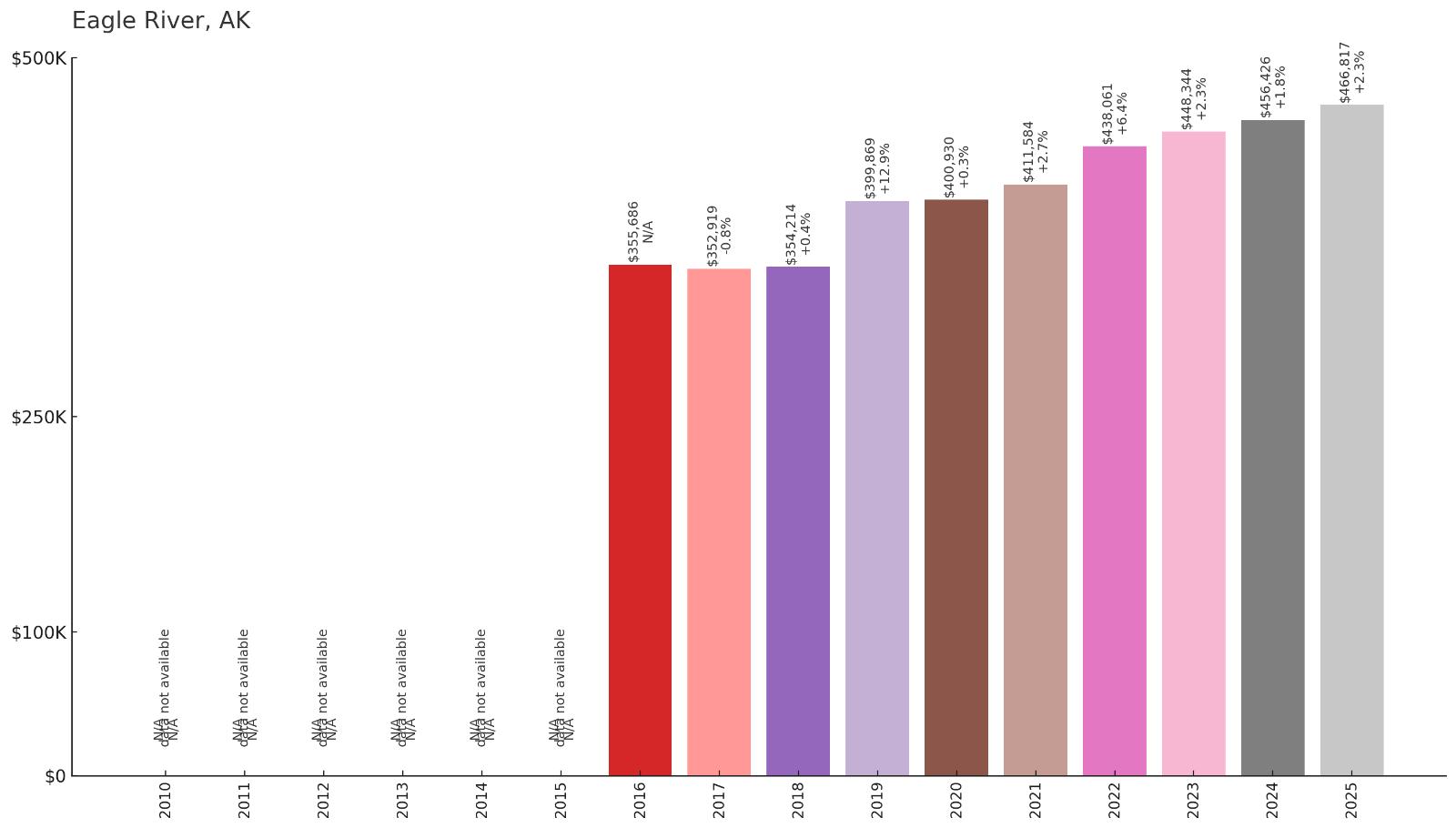
- 2010: N/A
- 2011: N/A
- 2012: N/A
- 2013: N/A
- 2014: N/A
- 2015: N/A
- 2016: $355,686
- 2017: $352,919
- 2018: $354,214
- 2019: $399,869
- 2020: $400,930
- 2021: $411,584
- 2022: $438,061
- 2023: $448,344
- 2024: $456,426
- 2025: $466,817
Eagle River has shown steady appreciation since data collection began in 2016, with values climbing from $355,686 to $466,817. The community demonstrated modest initial growth before accelerating significantly during 2019-2022. Recent years show continued strength with values reaching new highs annually, reflecting sustained demand in this desirable suburban community.
Why Eagle River?

Why Are People Willing to Pay So Much to Live Here? What’s Special About It?
Eagle River attracts residents seeking upscale suburban living with exceptional access to both Anchorage employment and world-class outdoor recreation. The community offers larger homes, quality schools, and family-friendly neighborhoods while maintaining easy commuting access to urban employment centers. Residents appreciate the area’s natural beauty, with hiking trails, rivers, and mountain access literally in their backyards.
The area provides an ideal balance of suburban convenience and Alaska wilderness access, with Chugach State Park and numerous recreational opportunities within walking distance of many homes. Property owners enjoy newer subdivisions, well-maintained infrastructure, and the community’s reputation as one of Alaska’s most desirable residential areas. The location offers the benefits of Anchorage proximity while maintaining a more relaxed, natural setting.
How Eagle River Rose to Prominence
Eagle River developed as part of the broader Anchorage metropolitan expansion during Alaska’s oil boom years of the 1970s and 1980s. The area’s scenic location along the Eagle River valley and proximity to Chugach State Park made it attractive for residential development. Early development focused on larger lots and custom homes that appealed to upper-income families.
The community’s growth accelerated as Anchorage expanded and residents sought suburban alternatives with better access to outdoor recreation. The area became incorporated as part of the Municipality of Anchorage while maintaining its distinct community identity. Careful development and the area’s natural amenities established Eagle River as one of Alaska’s premier residential communities.
3 Interesting Tidbits
1. State Park Access – Eagle River borders Chugach State Park, one of America’s largest state parks, providing residents with immediate access to hiking, skiing, and wildlife viewing.
2. Nature Center – The Eagle River Nature Center serves as a gateway to the park and offers year-round educational programs and trail access.
3. Salmon Runs – The Eagle River supports salmon runs that bring both fishing opportunities and wildlife viewing as bears congregate during spawning seasons.
4. Cooper Landing – 90% Home Price Increase Since 2012

- 2010: N/A
- 2011: N/A
- 2012: $250,842
- 2013: $256,695
- 2014: $264,007
- 2015: $278,805
- 2016: $295,786
- 2017: $310,172
- 2018: $314,512
- 2019: $323,524
- 2020: $338,421
- 2021: $386,193
- 2022: $421,857
- 2023: $395,648
- 2024: $426,839
- 2025: $475,985
Cooper Landing has achieved remarkable growth since data collection began in 2012, nearly doubling in value from $250,842 to $475,985. The community showed consistent appreciation through the 2010s before accelerating dramatically during 2020-2022. Despite some volatility, the strong 2025 performance demonstrates continued appeal in this premier fishing destination.
Why Cooper Landing?

Why Are People Willing to Pay So Much to Live Here? What’s Special About It?
Cooper Landing attracts residents and property owners with its legendary fishing opportunities along the turquoise waters of the Kenai River, consistently ranked among the world’s premier salmon and trout fisheries. The community sits in one of Alaska’s most spectacular settings, surrounded by the Chugach Mountains and bordered by pristine wilderness areas. Property owners enjoy waterfront access and mountain views while participating in a community centered around outdoor recreation and fishing guide services.
The area offers exceptional outdoor recreation beyond fishing, including hiking, rafting, and wildlife viewing in an unspoiled natural environment. Residents appreciate the small community atmosphere where everyone shares a passion for outdoor activities and environmental preservation. The location provides the perfect balance of wilderness access and reasonable connectivity to other Kenai Peninsula communities for supplies and services.
How Cooper Landing Rose to Prominence
Cooper Landing was established in 1884 as a trading post and way station during gold rush activities in the region. The community was named after Joseph Cooper, a prospector who found gold in the area and established a trading operation. Early development centered on serving miners and providing supplies for those heading to interior gold claims.
The area’s transformation into a fishing destination began in the mid-20th century as sport fishing tourism developed in Alaska. The Kenai River’s world-class salmon runs and crystal-clear waters attracted anglers from around the globe, establishing Cooper Landing as a premier fishing destination. The combination of natural beauty, exceptional fishing, and strategic location made it increasingly valuable for both tourism operations and residential properties.
3 Interesting Tidbits
1. Russian River – Cooper Landing sits at the confluence of the Kenai and Russian Rivers, creating one of Alaska’s most famous fishing spots for sockeye salmon.
2. Historic Lodge – Kenai Princess Wilderness Lodge and other historic lodges have hosted celebrities and dignitaries seeking world-class fishing experiences.
3. Wilderness Gateway – The community serves as a gateway to the Chugach National Forest and multiple wilderness areas accessible only by foot or boat.
3. Chugiak – 37% Home Price Increase Since 2016
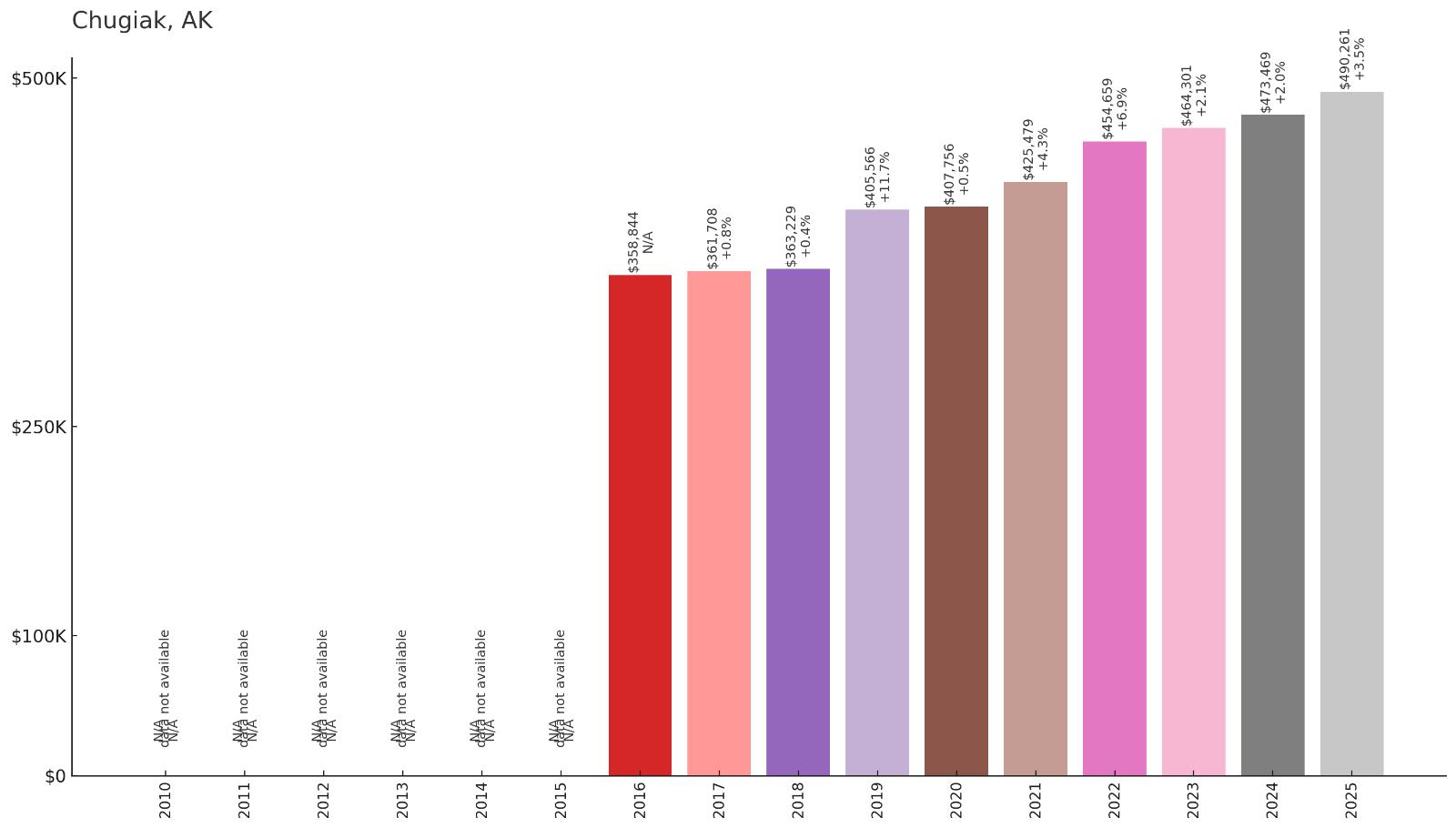
- 2010: N/A
- 2011: N/A
- 2012: N/A
- 2013: N/A
- 2014: N/A
- 2015: N/A
- 2016: $358,844
- 2017: $361,708
- 2018: $363,229
- 2019: $405,566
- 2020: $407,756
- 2021: $425,479
- 2022: $454,659
- 2023: $464,301
- 2024: $473,469
- 2025: $490,261
Chugiak has demonstrated steady appreciation since data collection began in 2016, with values climbing from $358,844 to $490,261. The community showed modest initial growth before accelerating significantly during 2019-2022. Recent years continue to show strength with values reaching new highs annually, reflecting sustained demand in this sought-after residential area.
Why Chugiak?

Why Are People Willing to Pay So Much to Live Here? What’s Special About It?
Chugiak attracts residents seeking rural residential living with larger lots and custom homes while maintaining reasonable access to Anchorage employment opportunities. The community offers a genuine small-town Alaska atmosphere with strong community connections, local businesses, and annual events that bring neighbors together. Residents appreciate the area’s natural beauty, wildlife viewing opportunities, and immediate access to hiking trails and outdoor recreation.
The area provides the perfect balance of privacy and community, with enough space for personal pursuits like workshops, gardens, or small-scale farming while maintaining neighborhood connections. Property owners enjoy mountain views, mature trees, and the area’s slightly rural character that sets it apart from more suburban developments. The community’s location provides access to both wilderness areas and urban amenities within a reasonable drive.
How Chugiak Rose to Prominence
Chugiak developed as one of the original homesteading areas in the Anchorage region during the mid-20th century, when federal programs opened land for agricultural and residential settlement. The community’s name comes from a Dena’ina Athabascan word referring to the area’s location. Early settlers were attracted by larger lots and the opportunity for more self-sufficient living compared to city options.
The area’s growth accelerated during Alaska’s oil boom years as families sought alternatives to urban living while maintaining access to Anchorage employment. Chugiak became known for its rural residential character, community events, and strong local identity. The area became incorporated as part of the Municipality of Anchorage while maintaining its distinct community character and small-town atmosphere.
3 Interesting Tidbits
1. Birchwood Airport – The community is home to Birchwood Airport, a popular general aviation facility serving private aircraft and recreational flying.
2. Community Events – Chugiak hosts traditional community events including the annual Bear Paw Festival that celebrates local culture and brings neighbors together.
3. Rural Character – Despite proximity to Anchorage, Chugiak maintains a rural residential feel with larger lots, mature trees, and wildlife commonly seen in residential areas.
2. Kachemak City – 77% Home Price Increase Since 2010

- 2010: $279,720
- 2011: $278,521
- 2012: $283,424
- 2013: $284,950
- 2014: $287,390
- 2015: $293,409
- 2016: $307,383
- 2017: $312,707
- 2018: $339,375
- 2019: $356,496
- 2020: $366,681
- 2021: $430,955
- 2022: $471,015
- 2023: $448,542
- 2024: $460,726
- 2025: $496,065
Kachemak City has achieved impressive growth since 2010, with values climbing from $279,720 to $496,065 over 15 years. The community showed steady but moderate appreciation through most of the 2010s before accelerating dramatically during 2018-2022. Despite some volatility, the strong 2025 performance reaching nearly $500,000 demonstrates continued appeal in this scenic coastal community.
Why Kachemak City?

Why Are People Willing to Pay So Much to Live Here? What’s Special About It?
Kachemak City attracts residents with its spectacular setting on the shores of Kachemak Bay, offering panoramic views of mountains, glaciers, and pristine waters. The community provides access to world-class fishing, kayaking, and wildlife viewing while maintaining a peaceful, rural atmosphere away from tourist crowds. Residents enjoy custom waterfront properties with private beaches and the opportunity for self-sufficient living in one of Alaska’s most scenic locations.
The area offers exceptional outdoor recreation opportunities including hiking, fishing, and boating in an unspoiled natural environment. Property owners appreciate the community’s commitment to environmental preservation and the area’s limited development that maintains its pristine character. The location provides stunning views and waterfront access while remaining accessible to Homer’s amenities and services.
How Kachemak City Rose to Prominence
Kachemak City developed as a small residential community on the shores of Kachemak Bay, originally settled by individuals seeking waterfront properties away from more developed areas. The community remained small and relatively unknown for decades, with residents valuing privacy and natural beauty over accessibility and services.
The area’s prominence grew as Alaska’s scenic coastal properties became increasingly valuable and sought after by those seeking luxury waterfront living. The combination of spectacular views, waterfront access, and proximity to Homer’s amenities made Kachemak City increasingly attractive to buyers seeking premium Alaska coastal properties. Environmental protections and limited development opportunities have helped maintain exclusivity and property values.
3 Interesting Tidbits
1. Waterfront Living – Most properties in Kachemak City feature direct waterfront access with private beaches and stunning views across Kachemak Bay.
2. Wildlife Viewing – The area offers exceptional wildlife viewing opportunities, with whales, sea otters, eagles, and bears commonly observed from residential properties.
3. Artists’ Haven – The scenic beauty and peaceful atmosphere have attracted artists and writers seeking inspiration in a pristine natural setting.
1. Sitka – 22% Home Price Increase Since 2016
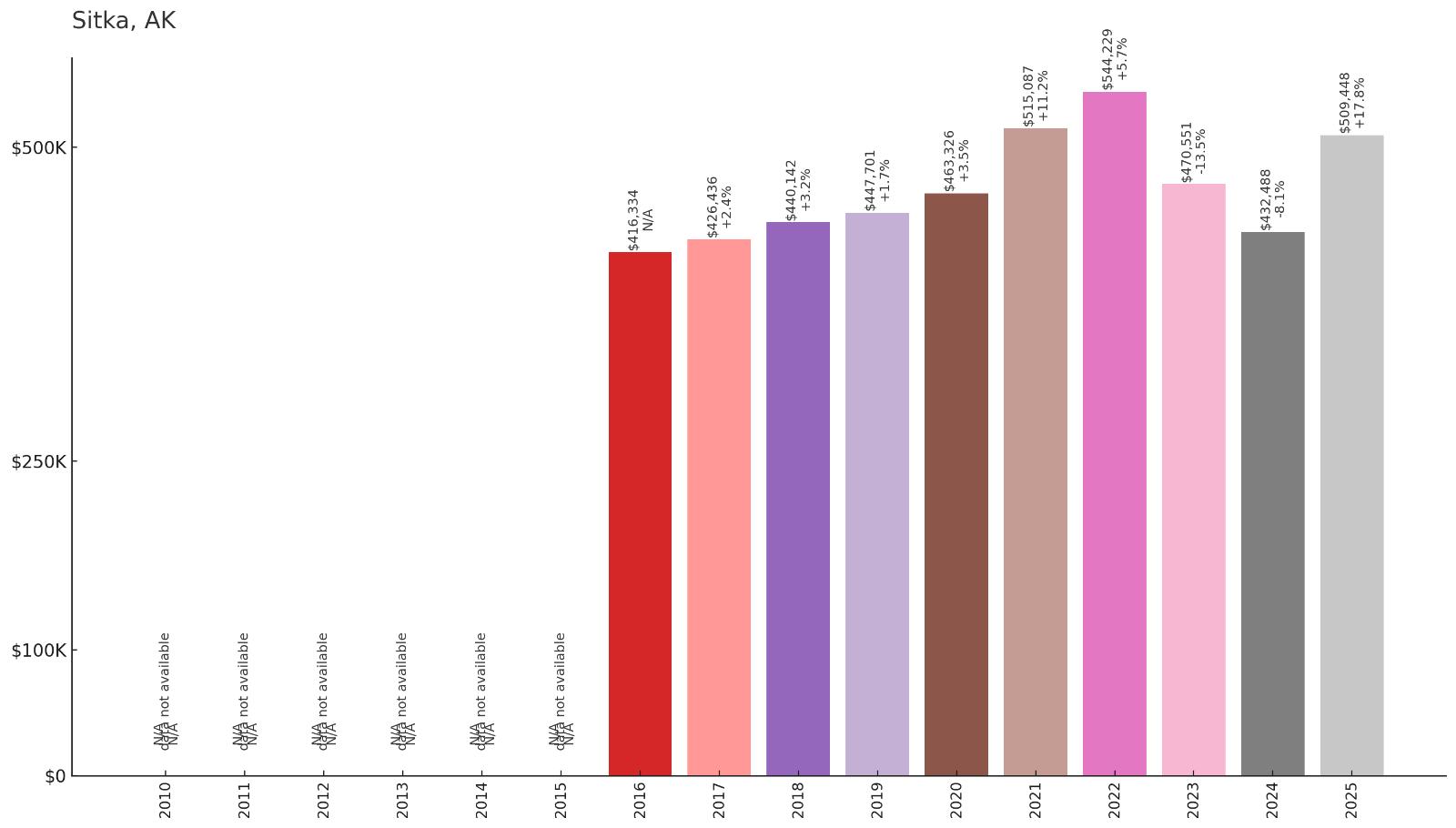
- 2010: N/A
- 2011: N/A
- 2012: N/A
- 2013: N/A
- 2014: N/A
- 2015: N/A
- 2016: $416,334
- 2017: $426,436
- 2018: $440,142
- 2019: $447,701
- 2020: $463,326
- 2021: $515,087
- 2022: $544,229
- 2023: $470,551
- 2024: $432,488
- 2025: $509,448
Sitka has shown moderate but volatile growth since data collection began in 2016, with values climbing from $416,334 to $509,448. The community demonstrated steady appreciation through 2022 when values peaked above $544,000, followed by significant cooling in 2023-2024. The strong 2025 rebound demonstrates underlying market strength despite recent volatility.
Why Sitka?

Why Are People Willing to Pay So Much to Live Here? What’s Special About It?
Sitka attracts residents with its unique combination of rich cultural history, stunning natural beauty, and sophisticated community amenities in an authentic Southeast Alaska setting. The community offers exceptional outdoor recreation including world-class fishing, hiking, and wildlife viewing, while maintaining cultural attractions like the Sitka Summer Music Festival and historical sites. Residents enjoy a genuine small-town atmosphere with strong community connections and access to quality healthcare, education, and cultural events.
The area provides unparalleled natural beauty with temperate rainforest, mountain views, and marine access creating an idyllic setting for those seeking the ultimate Alaska lifestyle. Property owners appreciate waterfront opportunities, historic neighborhoods, and the community’s commitment to preserving both cultural heritage and environmental quality. The location offers authentic Alaska living while maintaining sophisticated amenities and cultural richness.
How Sitka Rose to Prominence
Sitka served as the capital of Russian America from 1808 to 1867, making it one of Alaska’s most historically significant communities. The city was the center of Russian colonial administration, Orthodox missionary work, and fur trading operations throughout Alaska and the Pacific. The 1867 transfer of Alaska from Russia to the United States took place in Sitka, marking the end of Russian colonial period.
After Alaska’s purchase, Sitka remained the territorial capital until 1906 and continued as a major Southeast Alaska community. The city developed around fishing, timber, and government operations while maintaining its rich cultural heritage. Modern Sitka combines historical significance with natural beauty and cultural sophistication, establishing it as one of Alaska’s premier communities for those seeking authentic Alaska living with cultural depth.
3 Interesting Tidbits
1. Russian Capital – Sitka was the capital of Russian America for nearly 60 years and still features Russian Orthodox churches and colonial-era buildings.
2. Transfer Day – The formal transfer of Alaska from Russia to the United States occurred in Sitka on October 18, 1867, now celebrated annually as Alaska Day.
3. Music Festival – The Sitka Summer Music Festival attracts world-class musicians and audiences to this remote Alaska community each summer, showcasing classical music in a spectacular natural setting.





